Today, Leica has announced the SL3-S professional mirrorless camera. This new member of the SL family doesn't replace the existing SL3. Rather, the SL3-S complements it, offering enhanced video capabilities, superior low light performance, quicker autofocus, and faster sustained shooting, albeit at a lower resolution and lower price of $5,295.
Built on the same proven chassis and technology platform as the SL3, the SL3-S is virtually identical with the most obvious difference in its blacked-out LEICA engraving on the front of the viewfinder bump. More subtly, the model name engraving on the top of the hot shoe is also blacked-out. Otherwise, you'd have a hard time telling these two apart without diving into the tech specs.
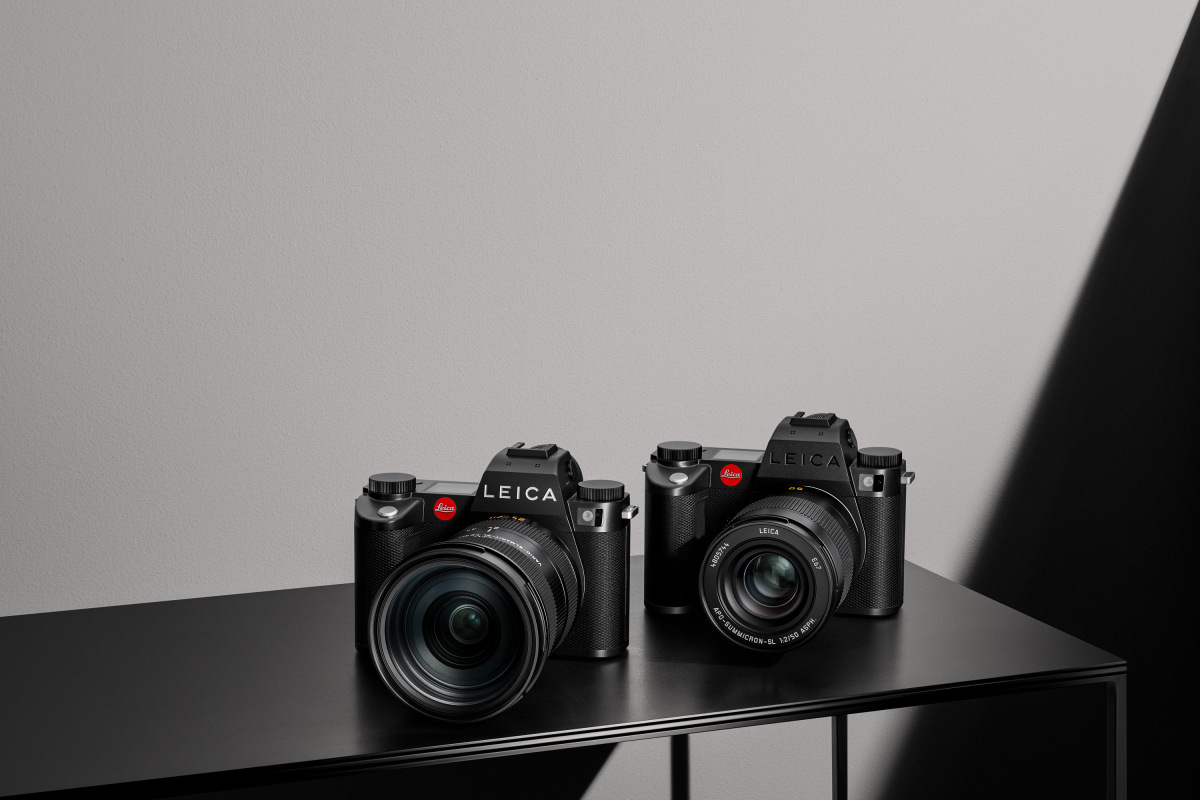
The SL3-S features all the same improvements to the body and UI, while adding some serious speed and video production capabilities. Outfitted with a new 24 megapixel BSI-CMOS sensor and the latest Maestro IV processor with 8GB of buffer memory, the SL3-S can fire off bursts of 30 frames per second with full autofocus tracking. On the video side, the camera opens up new possibilities with 6K Open Gate mode to utilize the full 24x36mm sensor, internal ProRes 422HQ for all resolutions, the ability to record internally to SD, CFe or SSD via USB-C, and 6K RAW over HDMI.
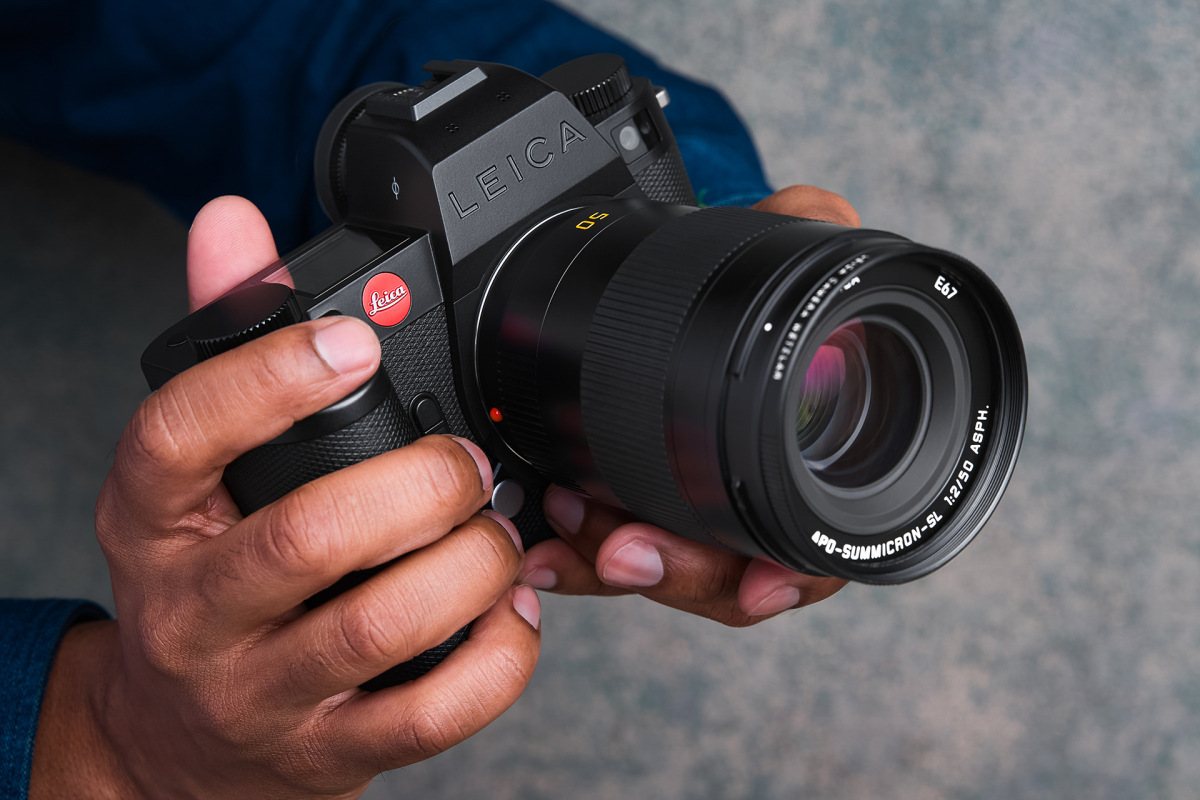
Features at a Glance
- New 24 Megapixel BSI CMOS Sensory
- ISO range from 50 to 200,000
- New Advanced Hybrid AF-System (PDAF + Contrast Detection AF + Object Detection AF) with 779 AF points
- Maestro IV Processor with L2 Technology and 8GB of buffer memory
- 30 fps capture in AFc mode
- Handheld Multishot mode up to 96 Megapixels
- Leica Content Credentials Support with hardware encryption chip
- CF Express Type B and SD UHS II
- HDMI 2.1 Type A (Full size)
- USB-C (3.1 incl. charging)
- Timecode Interface
- Optimized ergonomics, size and weight
- Tiltable high resolution touchscreen
- 5.76 million dot OLED Viewfinder with up to 120fps
- IP54 certification
- Unlimited 6K Open Gate Internal Recording
- Unlimited 5.8K Internal ProRes 422 HQ Recording
- 5.9K 12bit ProRes RAW External Video Recording
- High-Speed connectivity (Bluetooth + Wi-Fi 2×2 MIMO)
- Direct to SSD recording via USB-C
- Camera to Cloud with Frame.io planned in 2025
- Optional DC-Coupler and Double-Charger
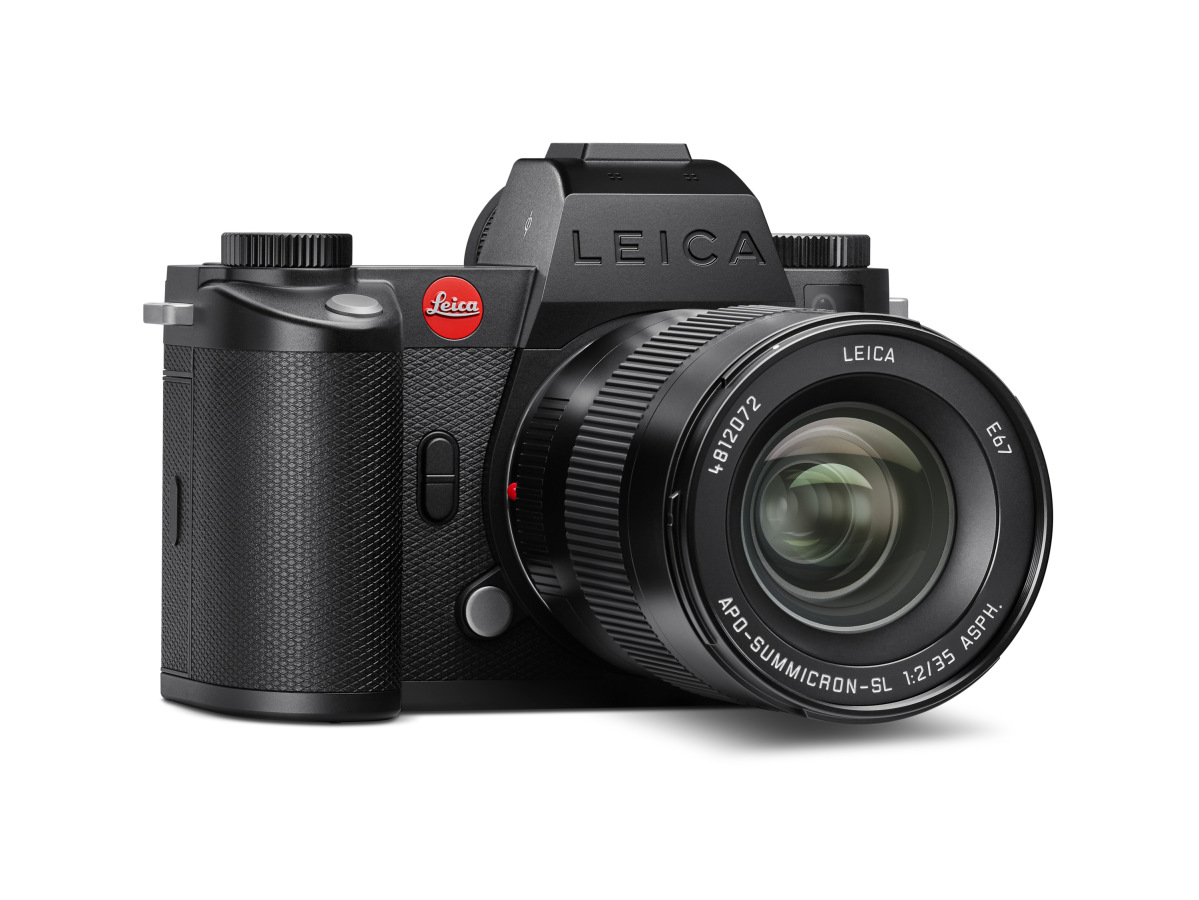
New Features from SL2-S
The SL3-S features many of the updates from the SL3, along with some unique improvements. These add up to big changes from the SL2-S, this camera's direct predecessor. Let's dive into some of the details.
New 24MP Sensor
Under the hood, Leica has endowed the SL3-S with a newly-designed 24 megapixel full frame BSI, or Back Side Illuminated, CMOS sensor. And in true Leica fashion, the chip eschews the detail-robbing optical low pass filter and going for maximum detail rendition. The sensor is mated to the same blazing fast Maestro IV processor found in the SL3. But with half the pixels to crunch through, the SL3-S offers a tangible speed advantage, both in terms of raw speed as well as burst depth. Also, ISO range has been expanded even further than before, from ISO 50-200,000, with base ISO now at 100.
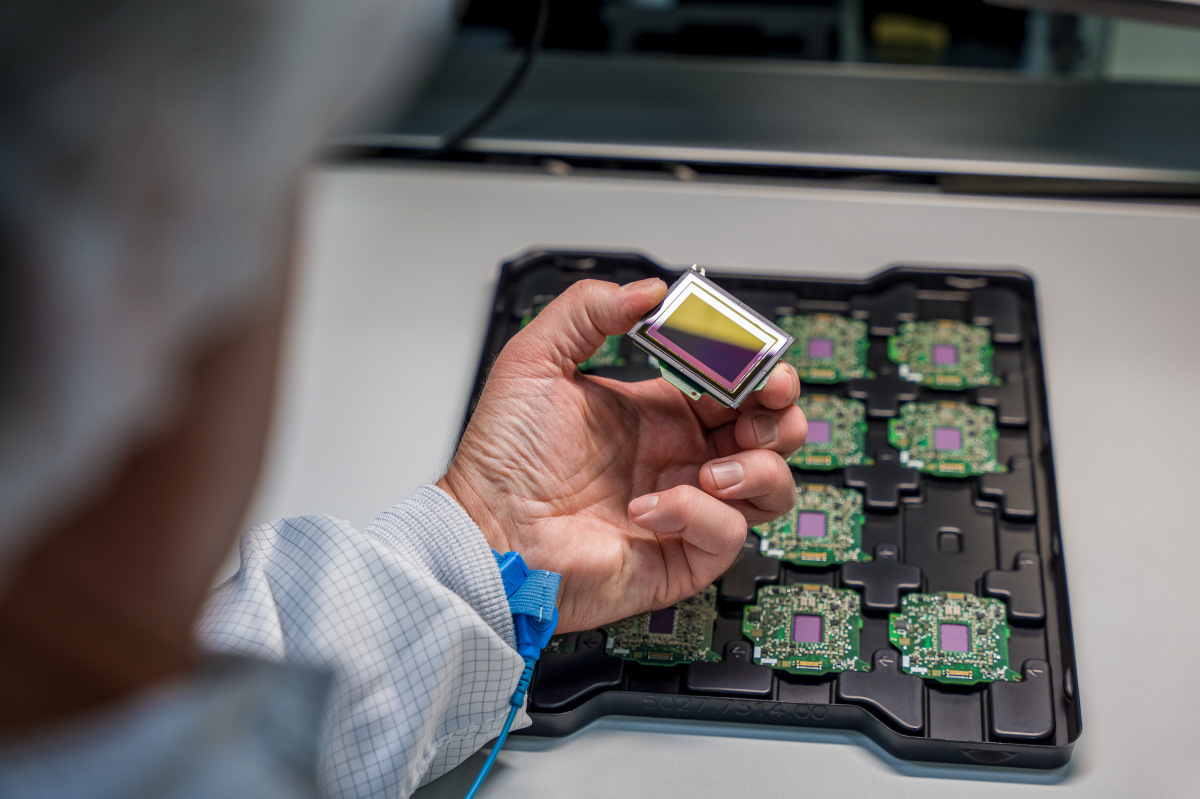
Maestro IV Processor + 8GB Buffer
The next-generation custom Maestro IV processor inside the SL3-S packs some serious horsepower. The SL3-S boasts a maximum burst rate of 30 fps, with full autofocus tracking. And with a generous 8GB of buffer memory, the burst depths are massive. At up to 5 fps, you can shoot 1,000 14-bit DNG files before the camera will bat an eye. Even at the maximum 30 fps, the camera will manage 175 shots before hitting the buffer. Regardless of how you shoot, you'll never have to wait for the camera to keep up.
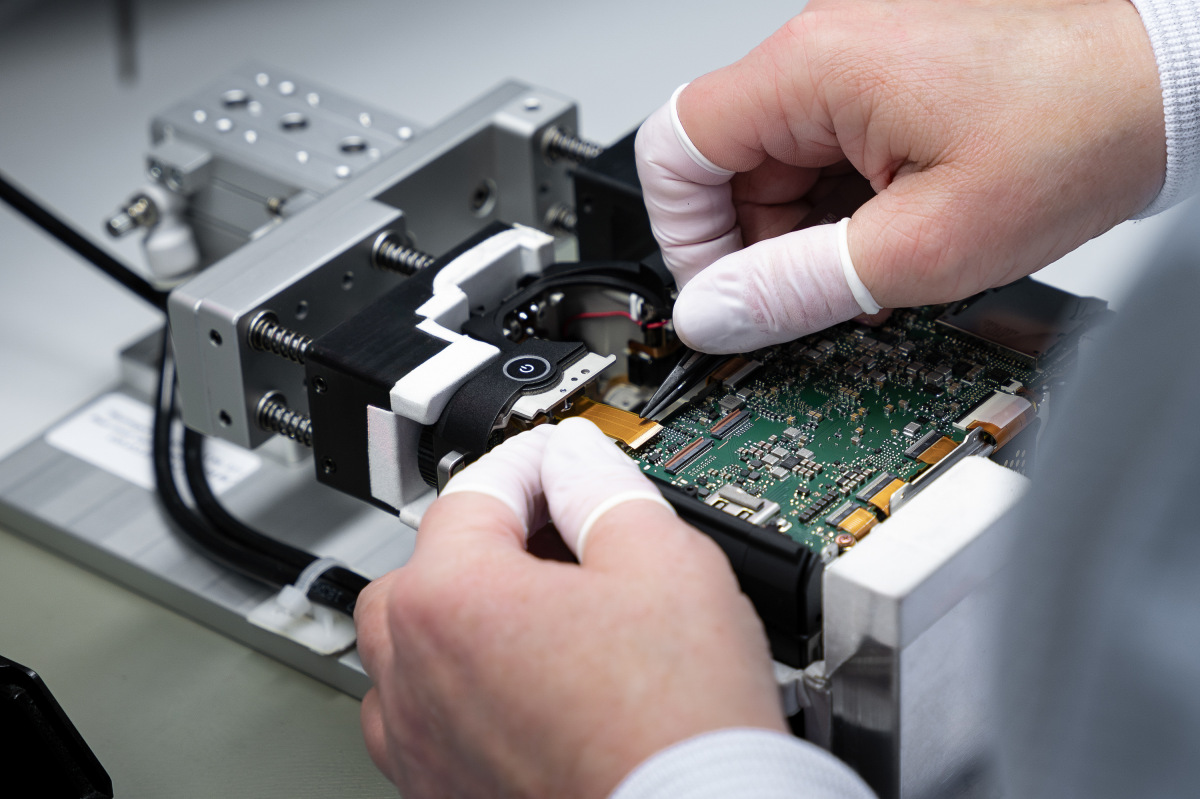
Handheld 96 MP Multishot
If you're worried that 24 megapixels won't be enough resolution for that epic sunrise or billboard-sized architectural shot, the SL3-S features a 96 megapixel multishot mode. This is nothing new. The SL2-S has the same, utilizing the IBIS system to shift the sensor mere pixels around for eight captures. But, the SL3-S has a new trick up its sleeve…you can use the mutlishot mode hand-held. So, when the moment strikes and you don't have a tripod, the camera can still deliver.
New Autofocus with Contrast and Phase Detection
The SL3-S features an even more advanced hybrid autofocus system which was debuted on the Q3 and SL3. Employing traditional contrast detection as well as a phase detect, combined with depth mapping and AI-driven subject recognition, the AF is faster and more accurate than ever. Eye/Face/Body + Animal Detection works remarkably well, and assures sharp focus even for moving subjects. And, the SL3-S employs 779 AF points, more than 3x that of the SL2-S, providing for much more nuanced acquisition and tracking.
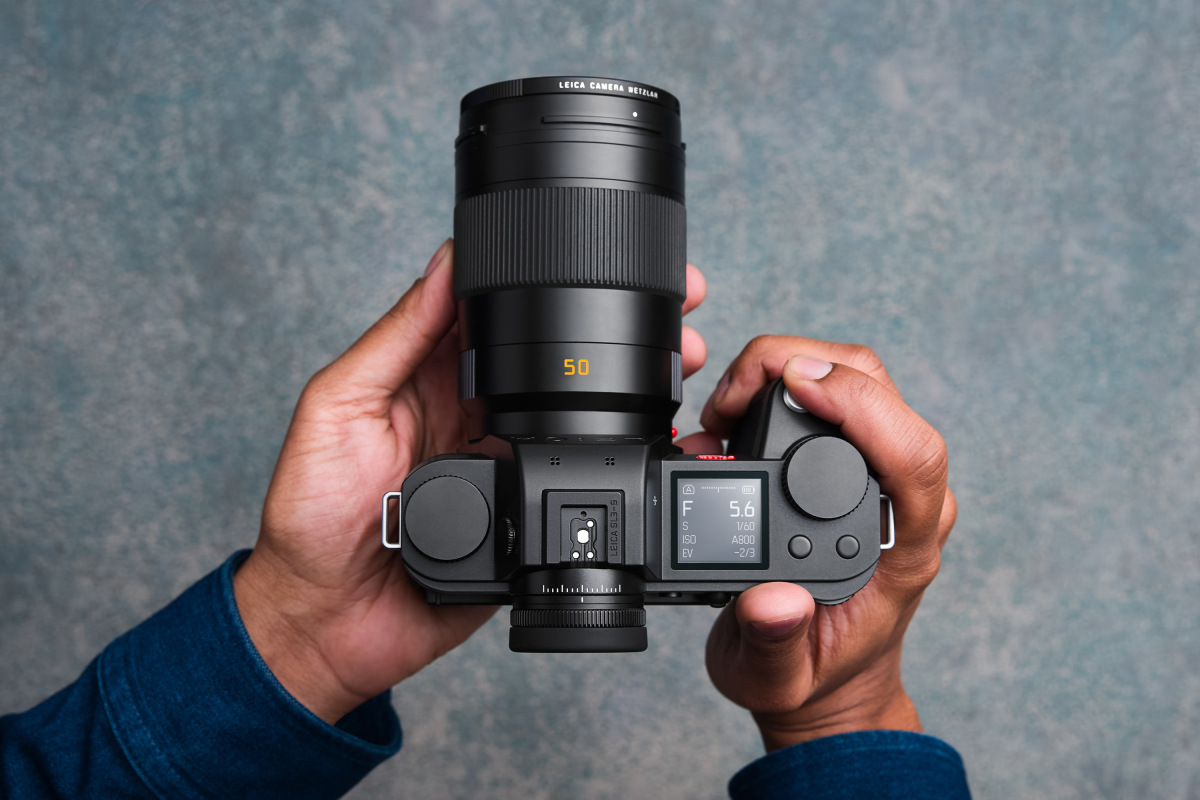
Expanded Video Capabilities
This is where the rubber meets the road for the SL3-S. The new 6K Open Gate recording option is incredible. Capturing the entire 24x36mm sensor area, 6K OG has two big advantages over traditional video modes. First, you can use any full frame lens that fits on the camera and capture its essence without any cropping. Think vintage R and M lenses. Or just stick to the exceptional native SL lenses with their unflinching corner-to-corner performance. The second advantage is the flexibility in cropping. Either that means adjusting the crop to account for the subject moving in frame, or to crop to any video aspect ratio without loss of quality. A common use case is using the same footage to create a 16:9 horizontal 4K video along with a 9:16 vertical video for social media, with no pixel scaling.
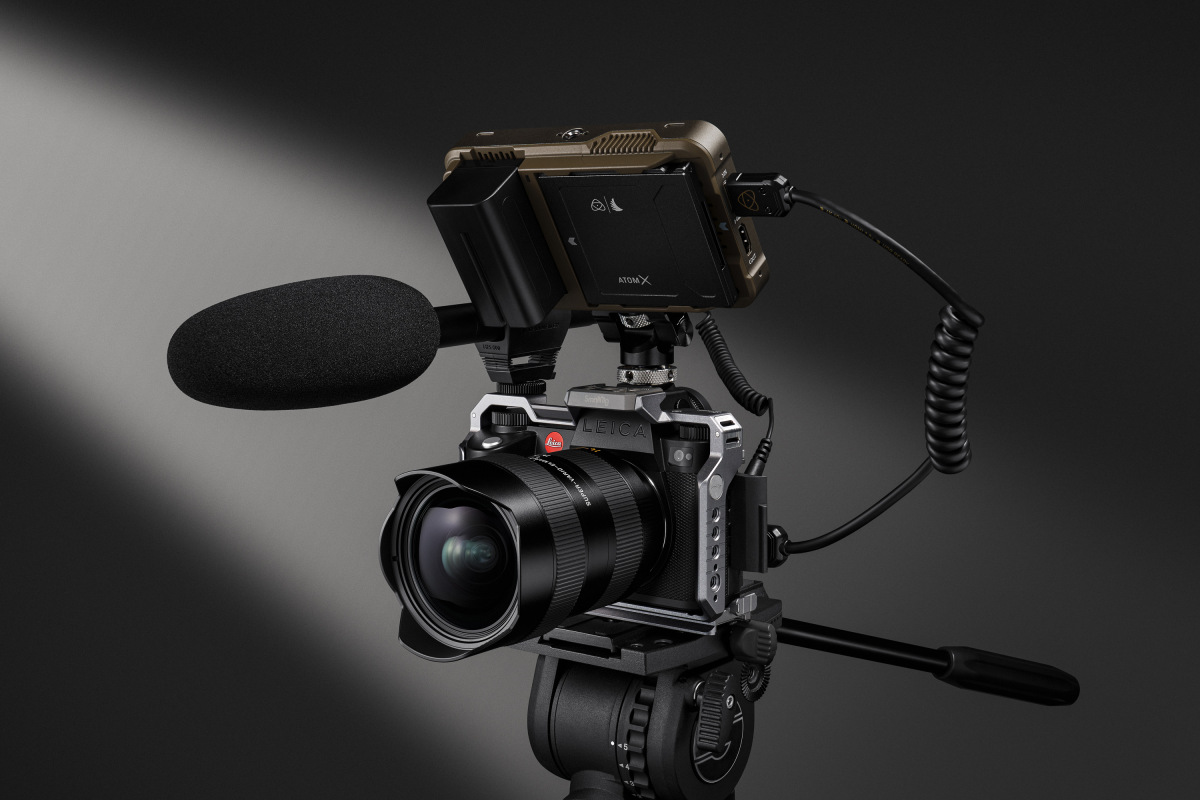
Along with 6K Open Gate, we've got all the options. Cine 6K, 6K, Cine 4K, 4K, Full HD can all be recored internally to CFe or SSD in ProRes 422HQ. Be aware that these are some massive files. At Cine 6K in ProRes, the bitrate hits a staggering 1939 Mbps. That's 242 MB per second, 14.5 GB per minute and 873 GB per hour of recording. You'd probably want to take advantage of a 2TB SSD for those two hours of ProRes footage. And for even more production flexibility, the SL3-S can output RAW video at 5.8K, C4K and 3.5K (4:3) to a compatible Atomos or Blackmagic recording monitor. Of course, regular old H.265 L-GOP and H.265 ALL-I recording options are available for all resolutions as well, when you just need a more straightforward workflow.
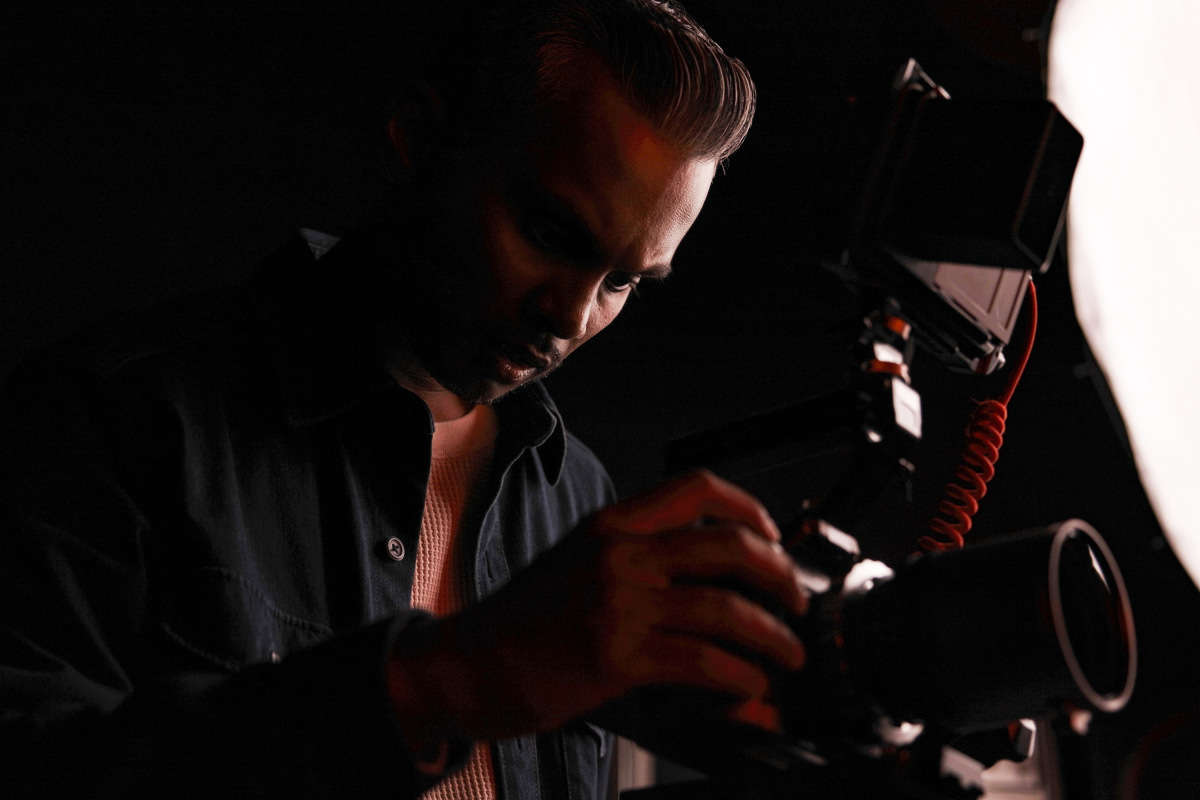
Leica Content Credentials
With the same hardware encryption chip found in the M11-P and M11-D, the SL3-S is also the first SL camera to offer Leica Content Credentials through the Content Authenticity Initiative, spearheaded by Adobe. With a dedicated secure chipset inside the camera storing a trusted certificate, each image is digitally signed using a C2PA confirmed algorithm. The encrypted metadata guarantees content integrity and origin verification. These credentials can't be modified without re-signing since the image and digital signature are cryptographically sealed together, ensuring that image provenance is accurate and protected. Over 300 companies have joined the Content Authenticity Initiative (CAI), but Leica is the first camera manufacturer to implement this technology at the hardware level.
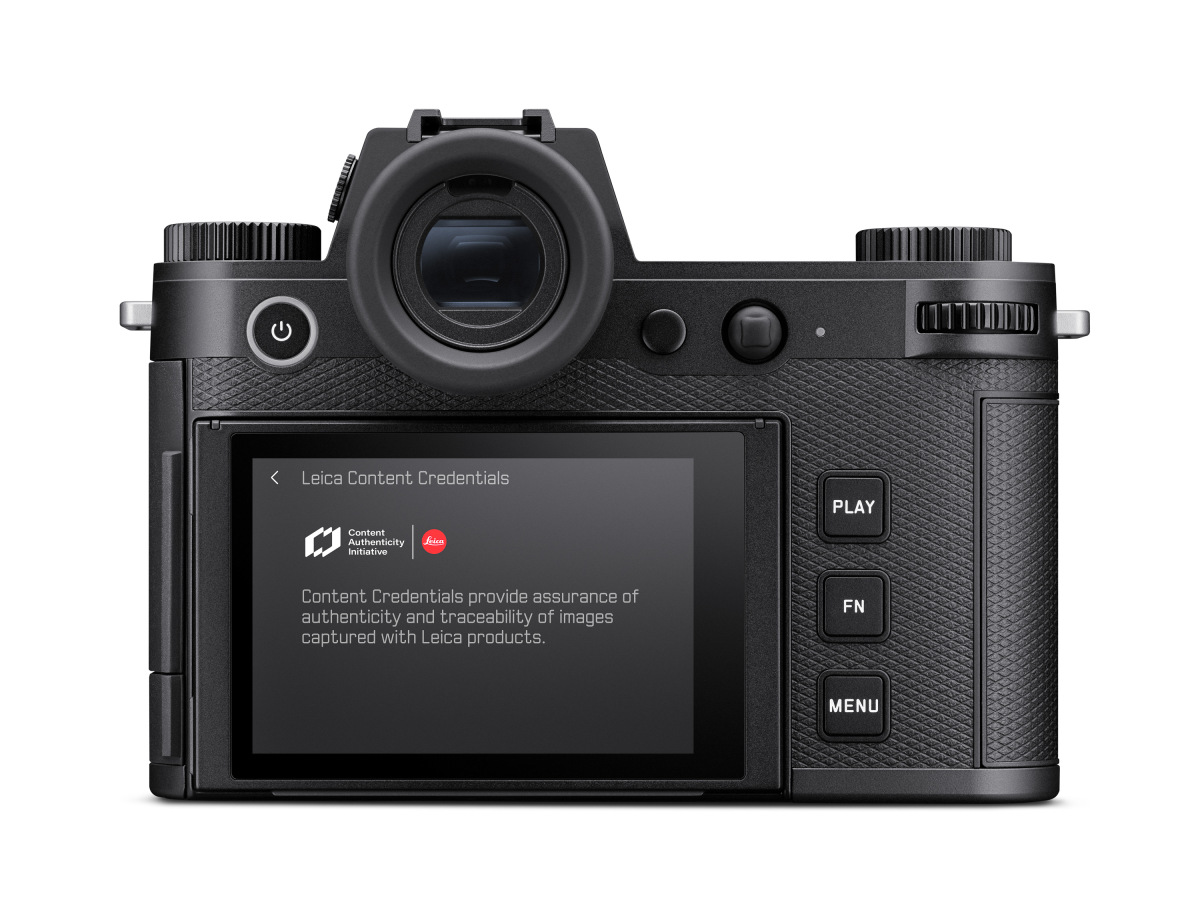
Smaller and lighter
Sharing the same body as the SL3, you can immediately tell that that the SL3-S is more compact than the SL2-S. Leica managed to shrink the dimensions both in length and in height. Standing three millimeters shorter than the SL2-S and five point two millimeters narrower from side to side, the camera still exudes the typical tank-like build synonymous with the Leica SL.
Along with the reduction in size, Leica has swapped out a full magnesium build for the previous aluminum construction. Along with a lighter-weight shutter mechanism, the SL3-S clocks in a 70 grams lighter than its predecessor. Make no mistake though. The camera is still rock solid and feels incredible in the hand. The chunky grip and diamond textured cladding offer a confident hold. And the camera is still IP54 weather sealed and rated for extreme temperatures. While Leica guarantees functionality from -10 to +40 Celsius, they test internally from -40 to +70 C, with an SL3 camera even surviving at a bone chilling -50 C during testing on an Antarctic expedition.
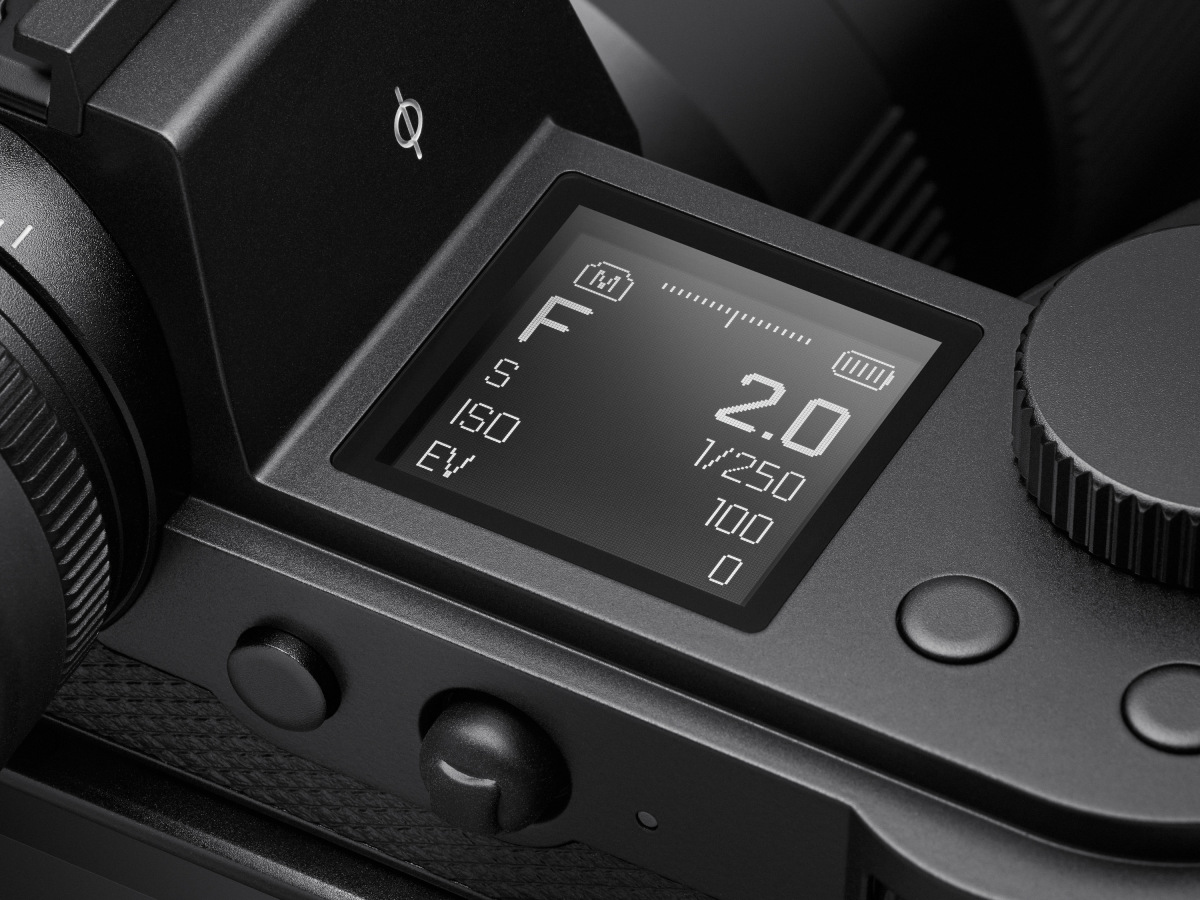
New tiltable rear LCD screen
Just like the SL3, the SL3-S sports an articulating rear LCD. Titling upwards and downwards, the screen offers additional flexibility for off-angle shooting. Whether holding overhead or close to the ground, the screen proves to be a useful addition. The 3.2-inch LCD touch panel itself gets upgraded from the SL2-S as well, now clocking in at 2.3 million dots.
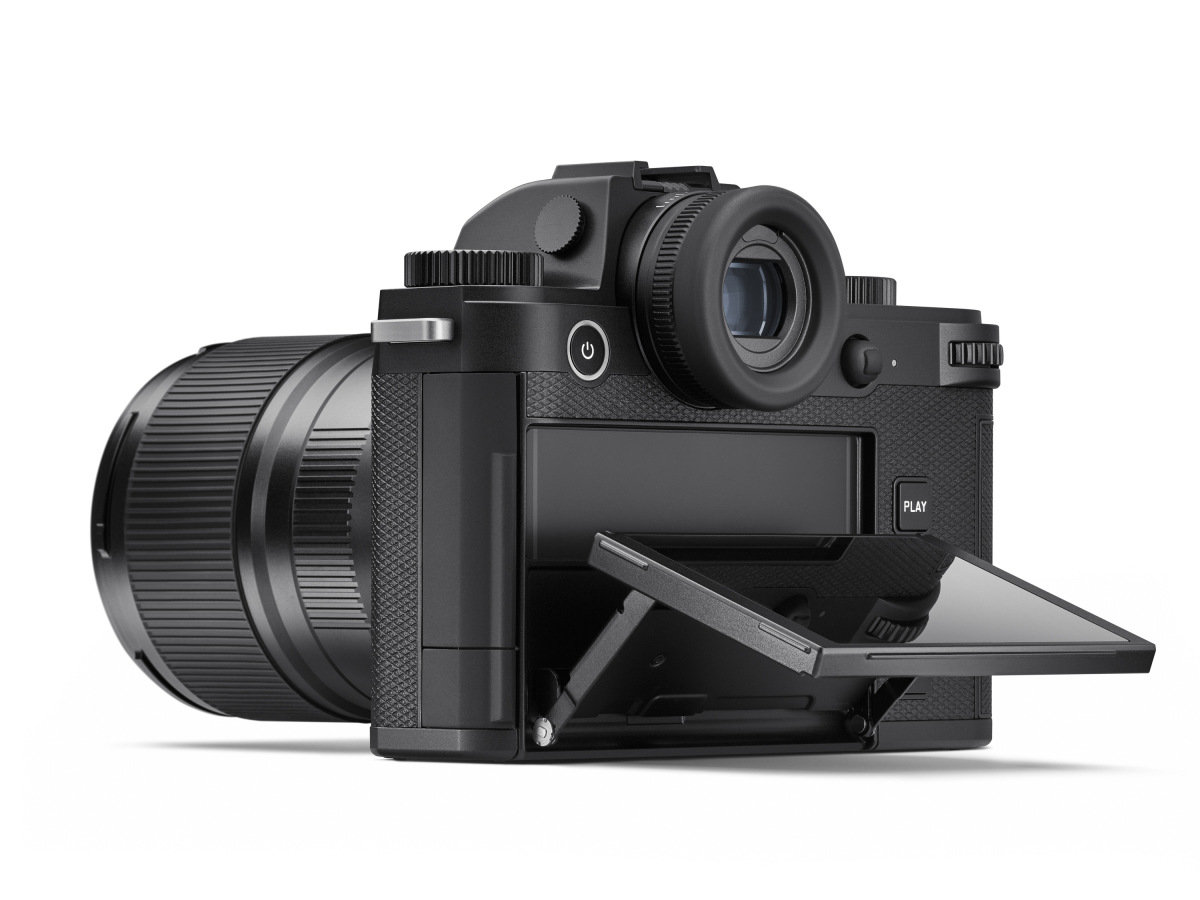
Revised control layout
In order to accommodate the new titling screen mechanism, the left-side buttons have been moved to the right of the screen. On the top shoulder of the camera, Leica has added an additional control wheel. Assignable like the one located next to the shutter release, this one defaults to ISO control, mirroring the ISO wheel on the top of the M11. Now, with two top dials and a rear thumb dial, all elements of exposure – ISO, aperture and shutter speed – can all be controlled intuitively with physical dials. As someone who often finds themselves in cold climates, having glove-friendly controls is a huge plus.
New power button
The power switch is now a power button, with an illuminated, multicolored LED ring surrounding it. Leica is clearly highlighting this as a major design shift for the SL3, with it featuring prominently in the initial startup animation. The possibilities of this LED look promising, but the underlying reason was one of functionality. As the SL3 and FOTOS app work much more closely and quicker together, the camera needs to be able to wake from sleep via the app.
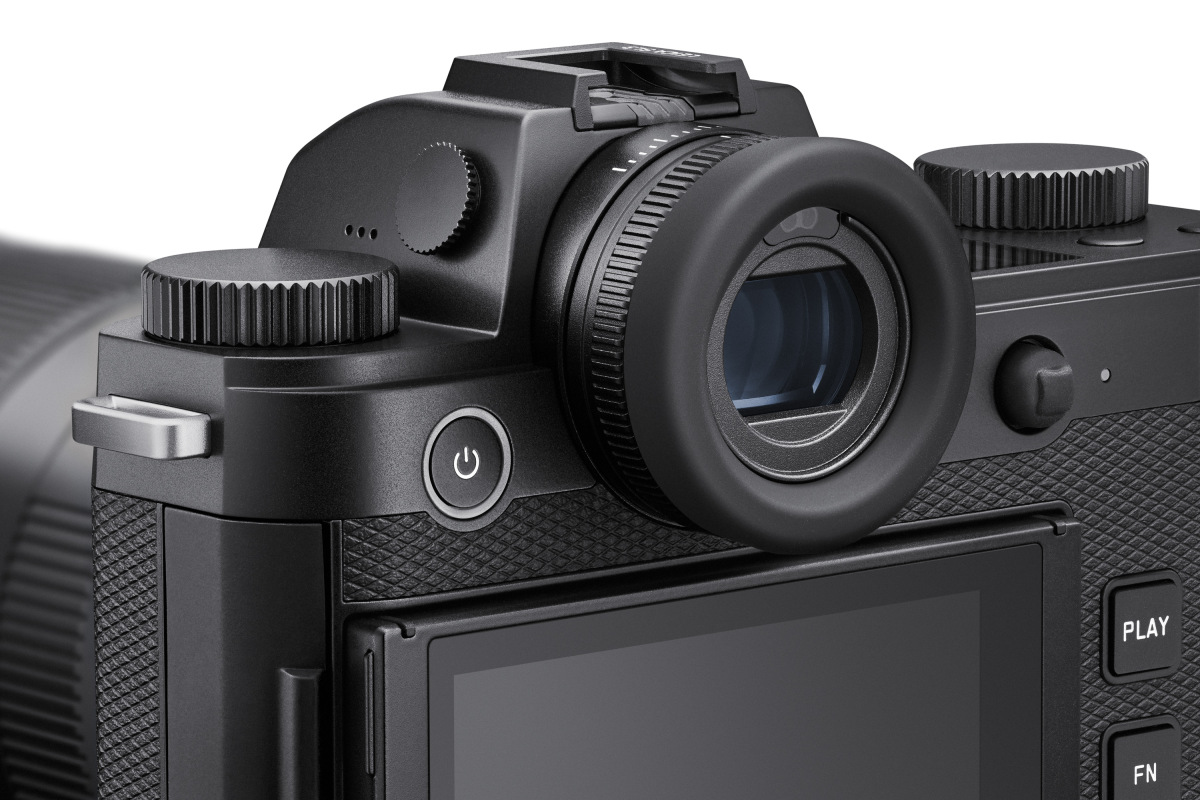
New User Interface (UI)
One of the biggest changes though isn’t readily visible from the outside. The new user interface has been completely redesigned and looks amazing. Clean, intuitive, responsive. Leica design at its best. The SL2-S UI was already one of the easiest to use on the market, but the menu system in the SL3-S is next level. Leica started with their fonts and status icons, increasing their size by a small but impactful ten percent. Line weights were harmonized, and icons were re-imagined to be as clear as possible. The design team coined the term ‘Leicons' to describe these and have over one hundred and fifty of them that they initially rolled out for the interface of the SL3.
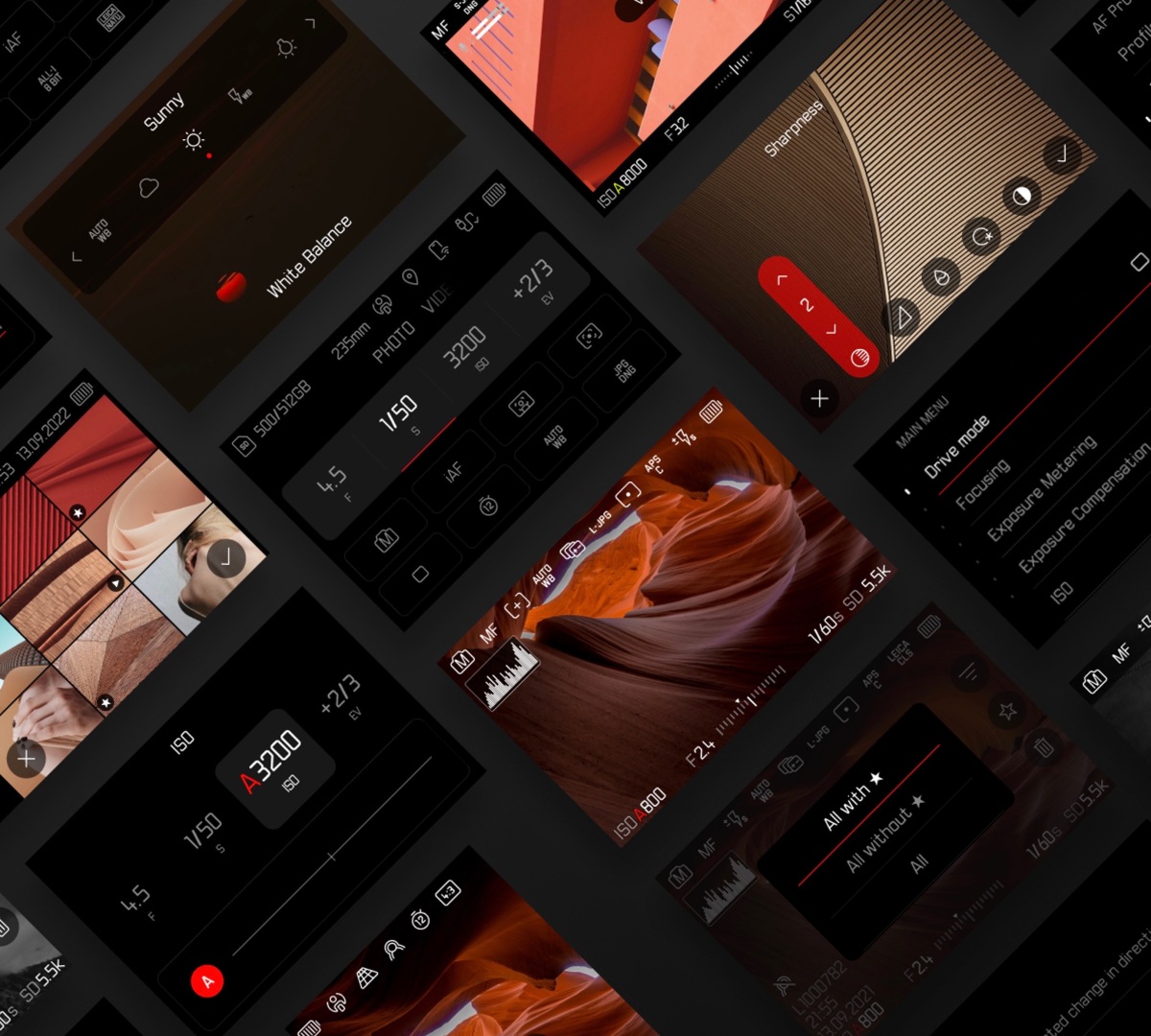
Along with the cleanup, the main control center screen buttons are touch assignable with long presses, a new toggle-style indicator for menu items is super clear, everything is touch friendly and the live view interface now rotates.
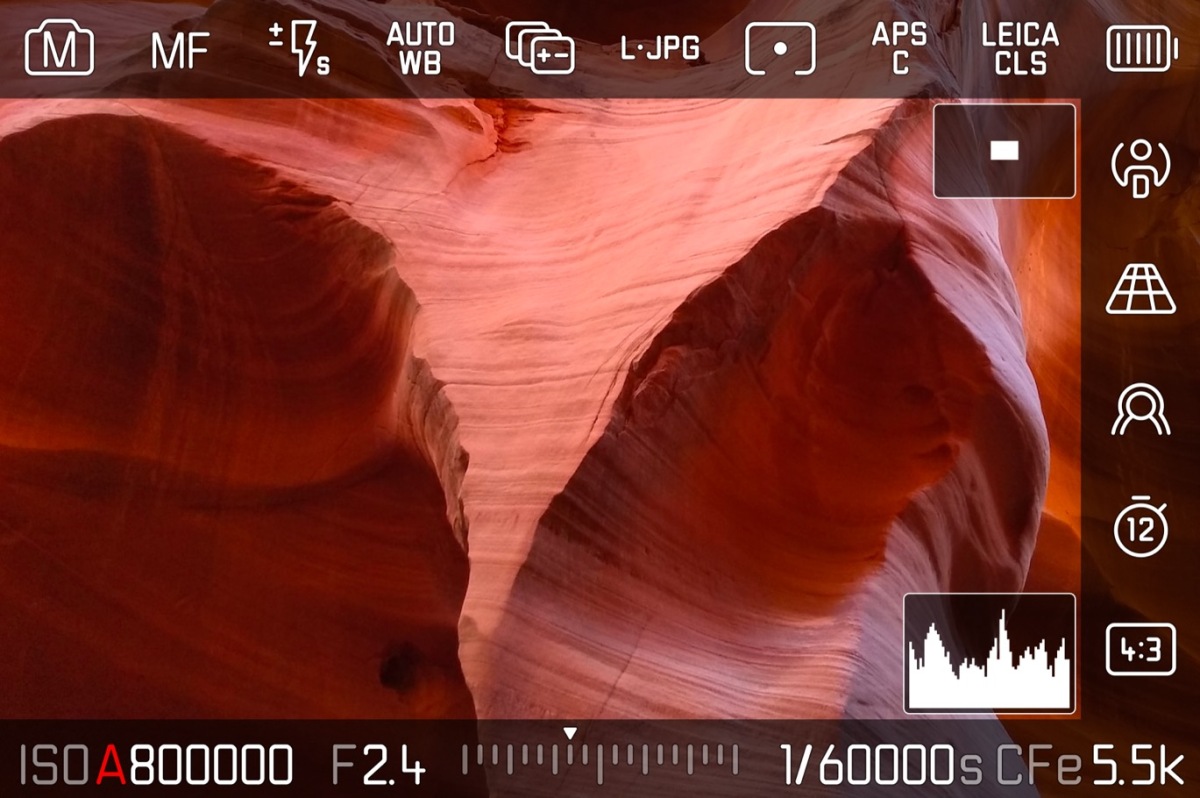
Users can control the overlay style of the icons in live view, with the addition of a customizable side bar. And the status overlay icons are clickable, to allow one touch quick changes while shooting. User profiles have been expanded, with six each for photo and video modes, and an entirely new video profile screen offers an easy way to change groups of video settings at once. The new UI is really one of the highlights of this camera.
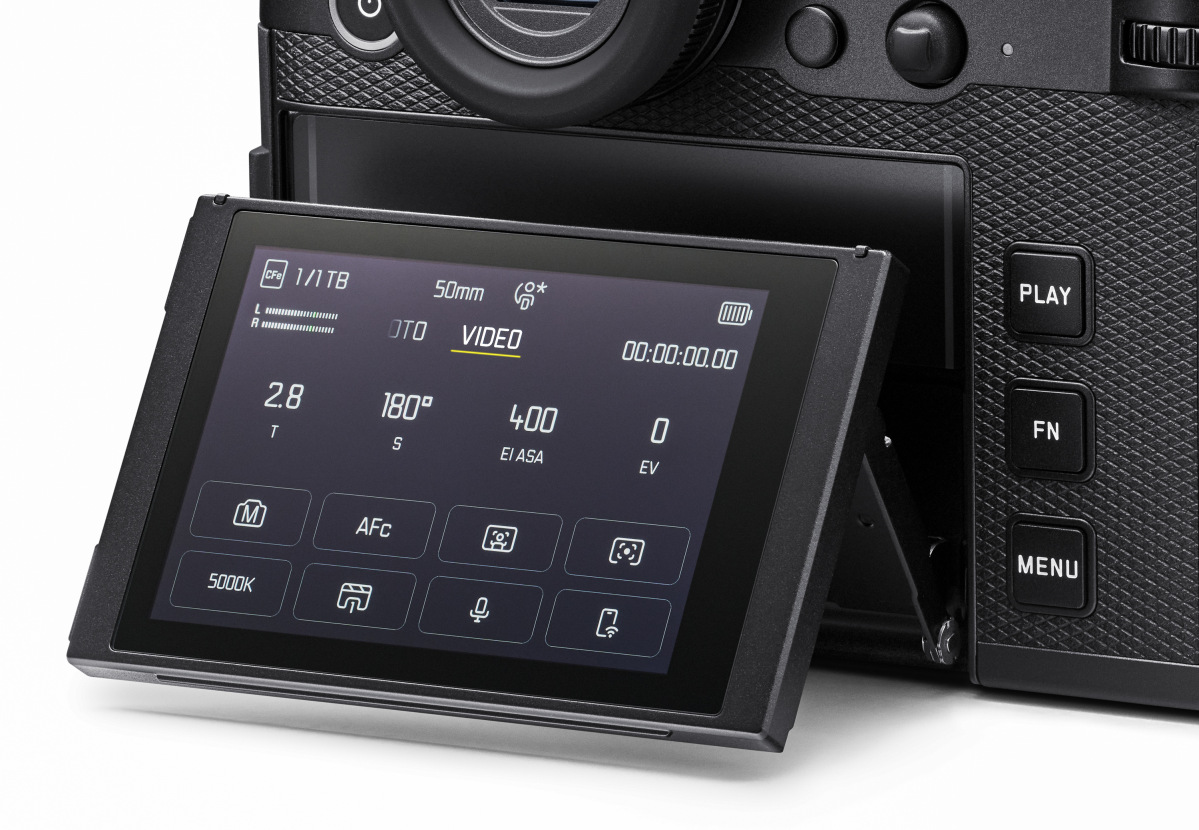
USB-C and HDMI Ports
The full-sized HDMI port gets a spec bump to HDMI 2.1 to support greater resolution and frame rate options when sending to an external recorder or capture card, and the USB-C port now features transfer speeds up to 100MB/s, resulting in file transfers of less than one second per DNG file. Tethered shooting to Capture One and Lightroom is fully supported. The USB-C port also accepts greater power input, up to 27W, providing quick in-camera battery charging.
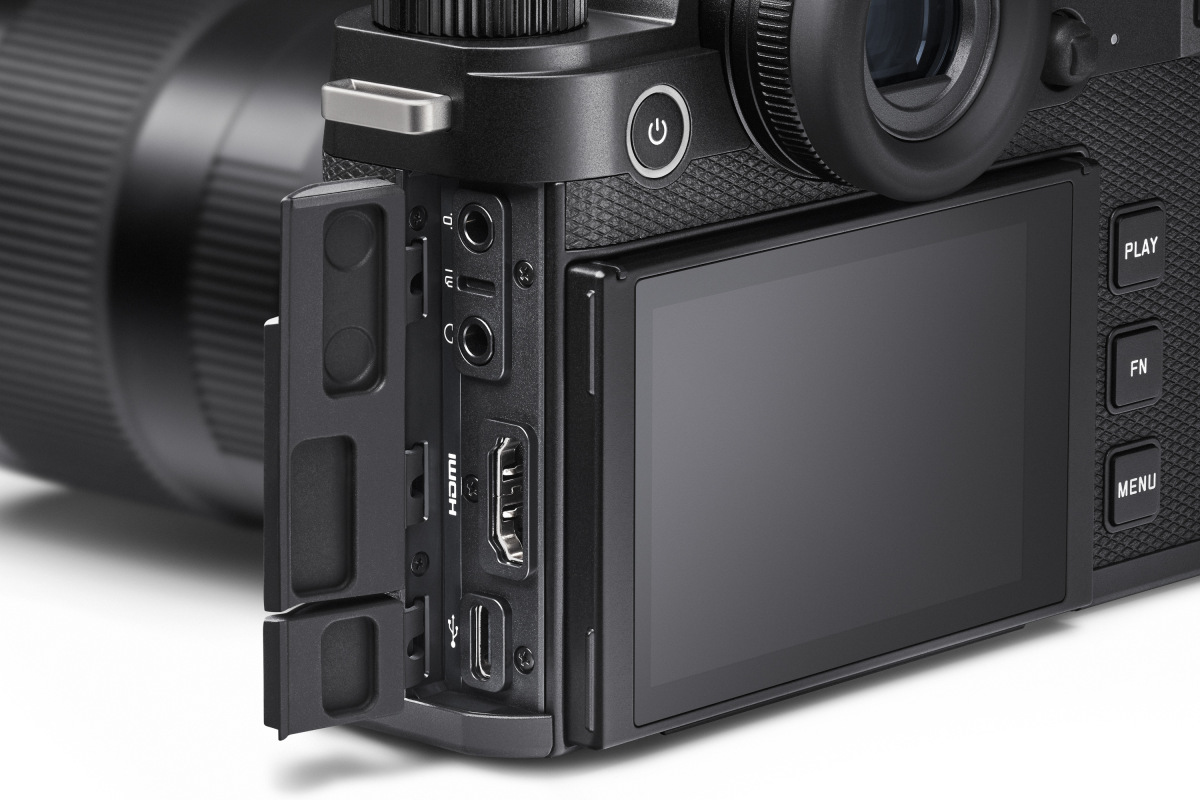
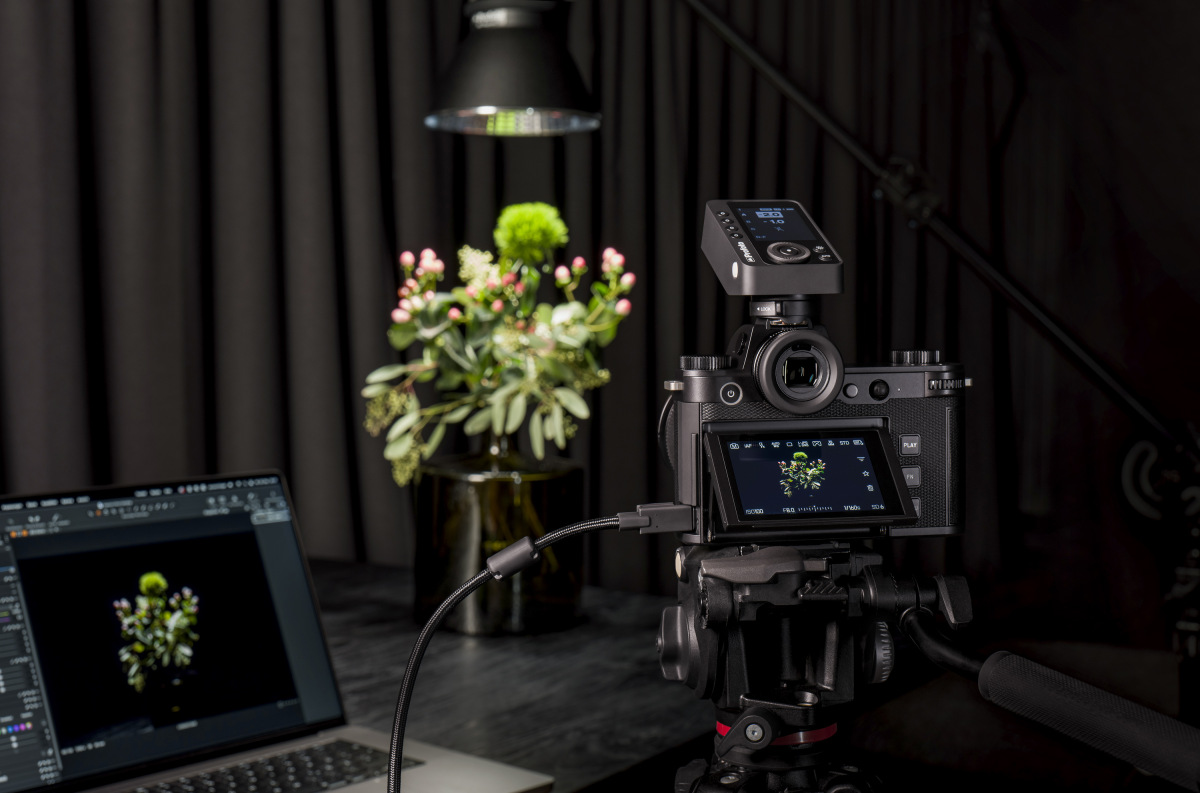
Upgraded Wi-Fi Speed
But you don't need a cable to enjoy rapid transfers to your mobile device. By incorporating MIMO 2×2 multichannel beam forming technology, the SL3-S boasts 10x faster wireless speeds than the first generation SL. Where DNG files could take 5 seconds or more to transfer from the SL2, the SL3-S can do so in about a second. Even browsing all of your pictures on the card from FOTOS feels snappy and responsive, especially with the addition of background image transfer in the latest version.
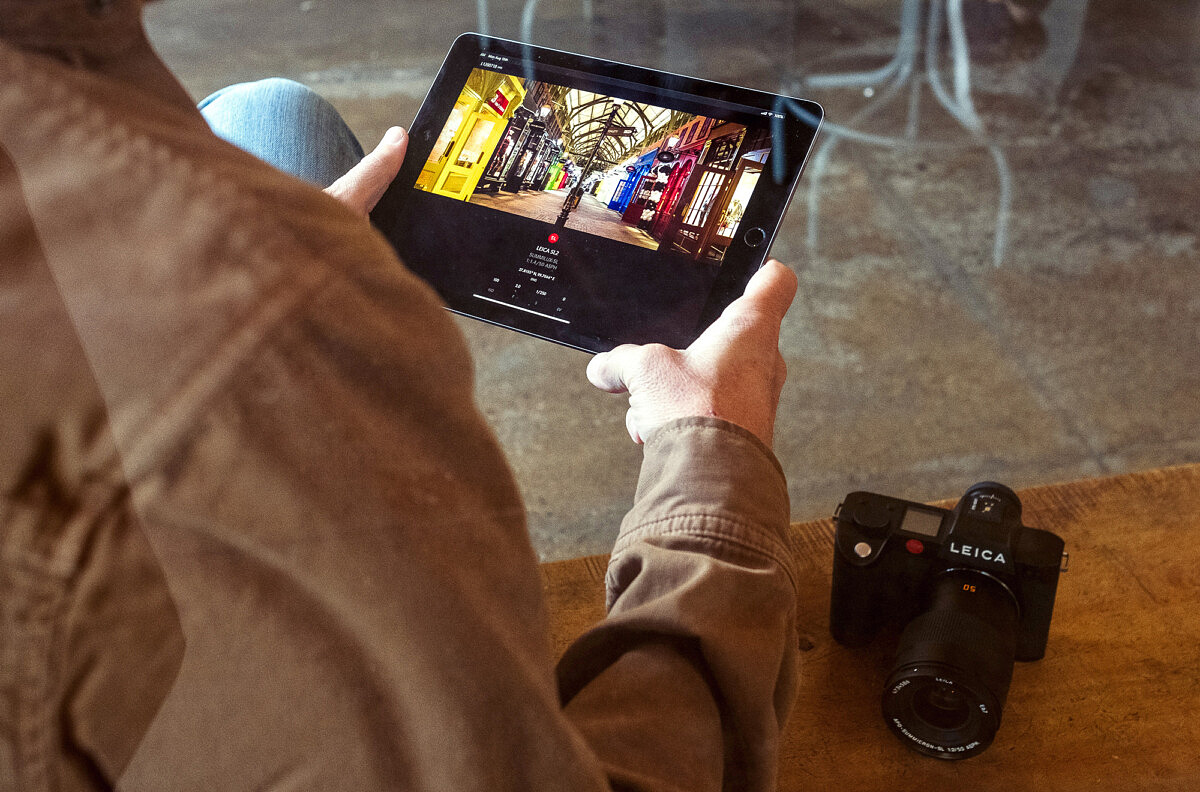
Upgraded Storage
Still offering a tried-and-true SDXC UHS-II slot for backup, the camera’s primary storage gets an upgrade to CompactFlash Express Type B. This means capacities greater than 1TB in size and speeds in excess of 2,000 MB/s. The cards are blazingly fast and when paired with a USB 3.2 Gen 2 reader, offer the fastest workflow available.
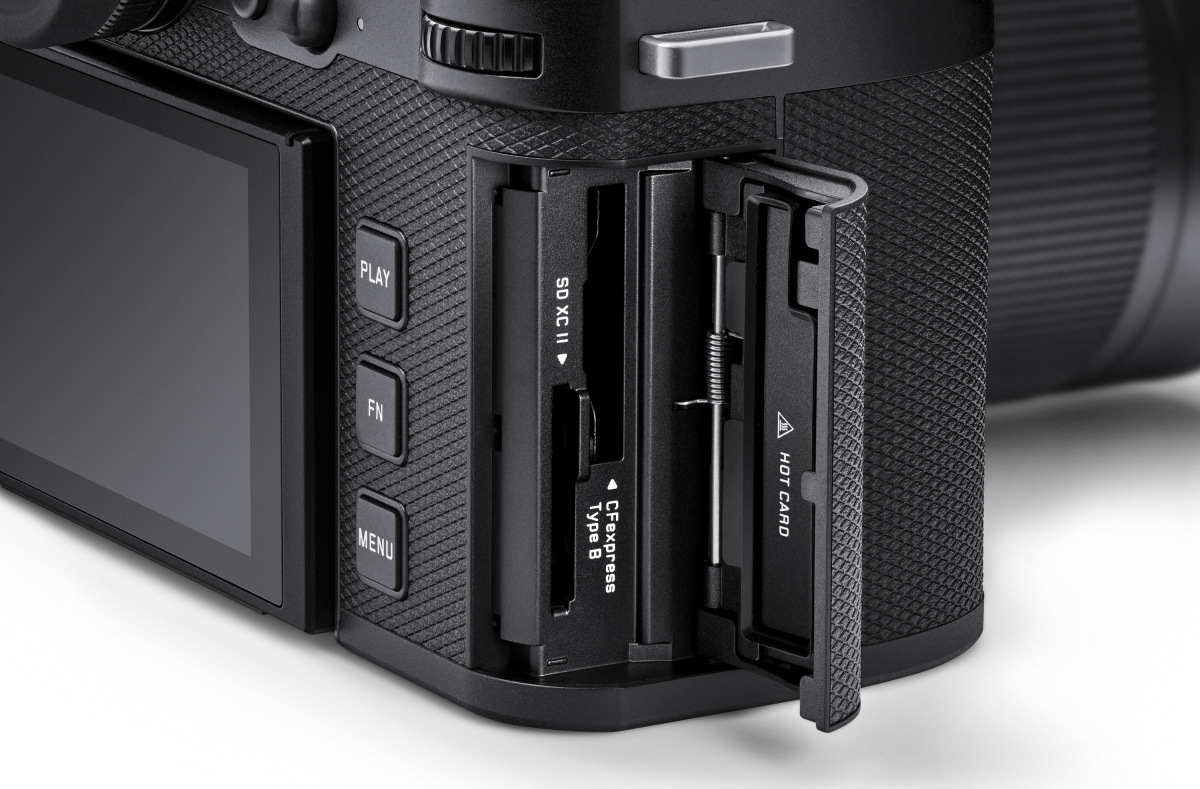
Record to SSD
The SL3-S also has the ability to record photos and video over USB-C to external SSDs up to 2TB. This gives an affordable and workflow friendly way to shoot large video projects, especially with the camera's beefed up video specs and massive file sizes.
New Battery
Physically the same dimensions as the BP-DC4 used in the Q2 and SL2, the newly introduced BP-DC6 has 2200mAh on tap for the increased performance of the SL3. The camera is still backwards compatible with the previous 1860mAh battery, but will have reduced battery life and will limit video functions to 4K along with a lower continuous shooting rate. We'd recommend upgrading to the new battery. And yes, the higher capacity BP-DC6 is fully backwards compatible and will work with the SL2, SL2-S and SL601.
New Charger and Power Accessories
The camera supports quick charging in body via USB-C power delivery. Leica recommends using at least a twenty-seven-watt USB-C wall adapter to get the fastest charging available. And don’t worry if all you have is a one hundred forty-watt adapter for you Macbook pro. The camera has intelligent charge circuitry that prevents overdrawing power.
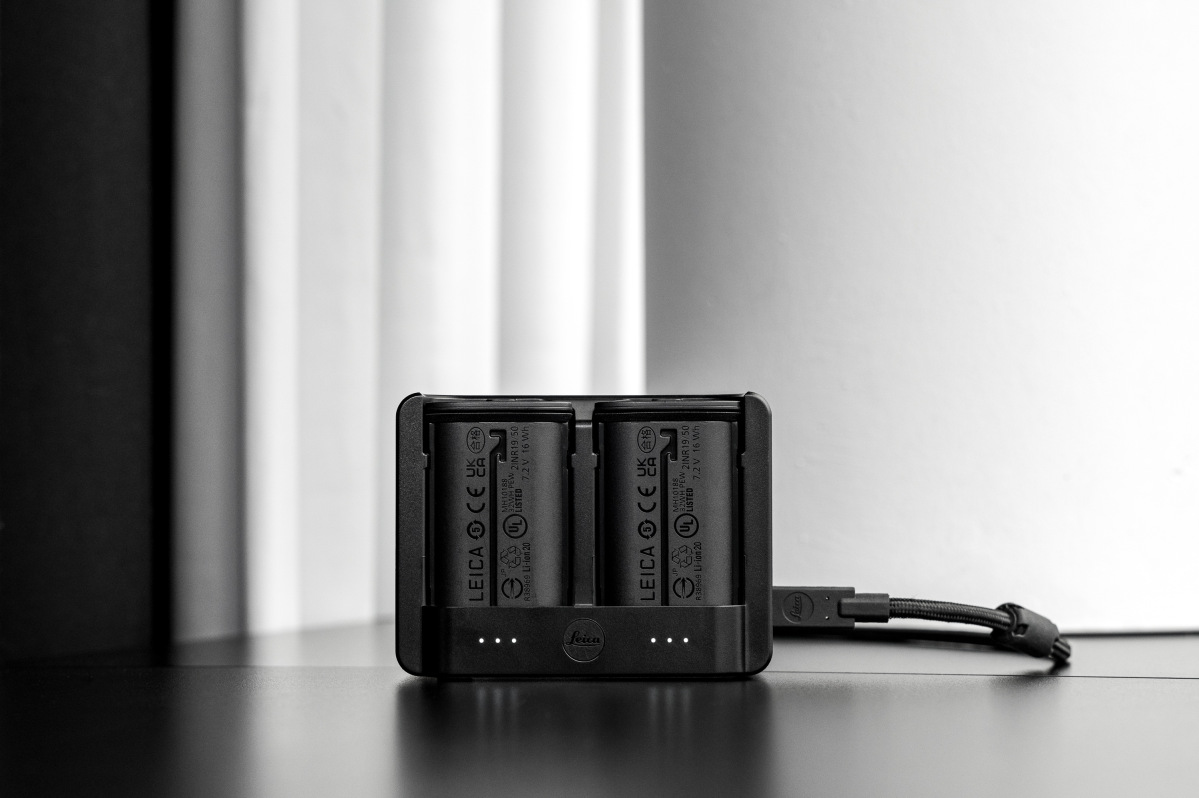
Of course, there is an available BC-SCL6 battery charger for those that want it. And thankfully, it’s a high-speed dual charger with convenient status LED lights for each battery. You can still use the legacy BP-SCL4 single charger from the SL2 and Q2 but charging will be a bit slower. Most SL3 owners will want to go for the Power Set, which includes the dual charger, an extra battery, AC adapter and extra charging cable. Leica is offering the set at a small discount over purchasing these pieces a la carte.
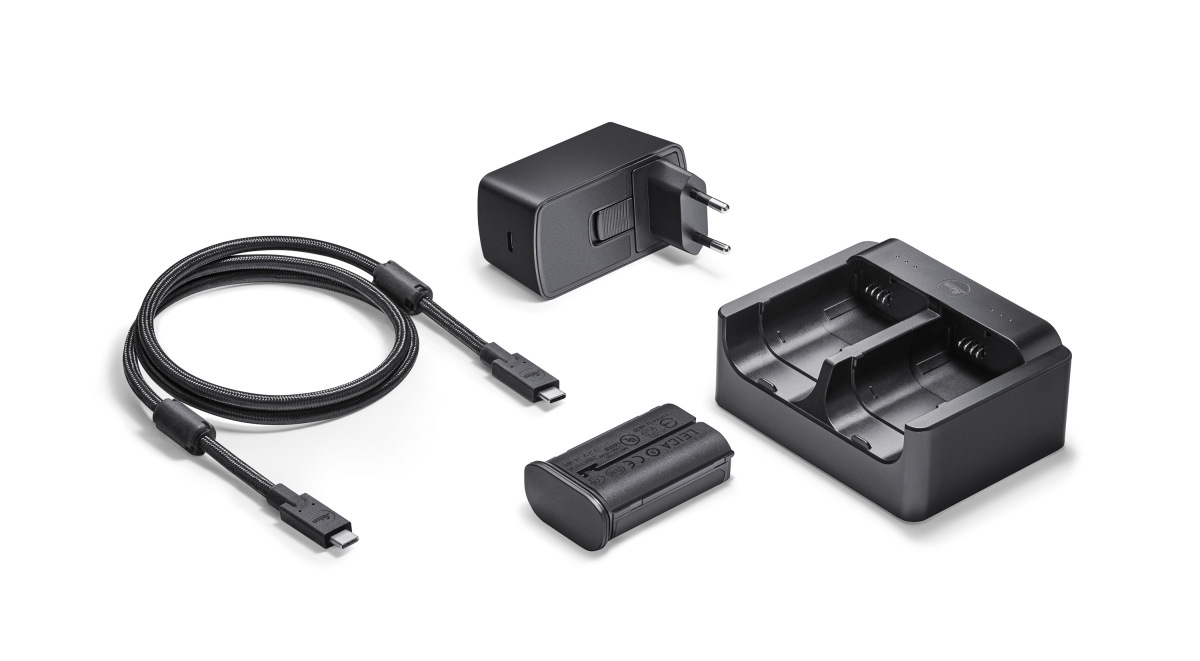
There is also a dummy battery, which Leica is calling a DC coupler. Both the new dual charger and the dummy battery come with USB-C inputs, allowing you to use a wide range of battery packs, wall adapters and longer charging cables. While the lack of an included charger seems like an oversight here, the enhanced USB-C charging ecosystem is a big win.
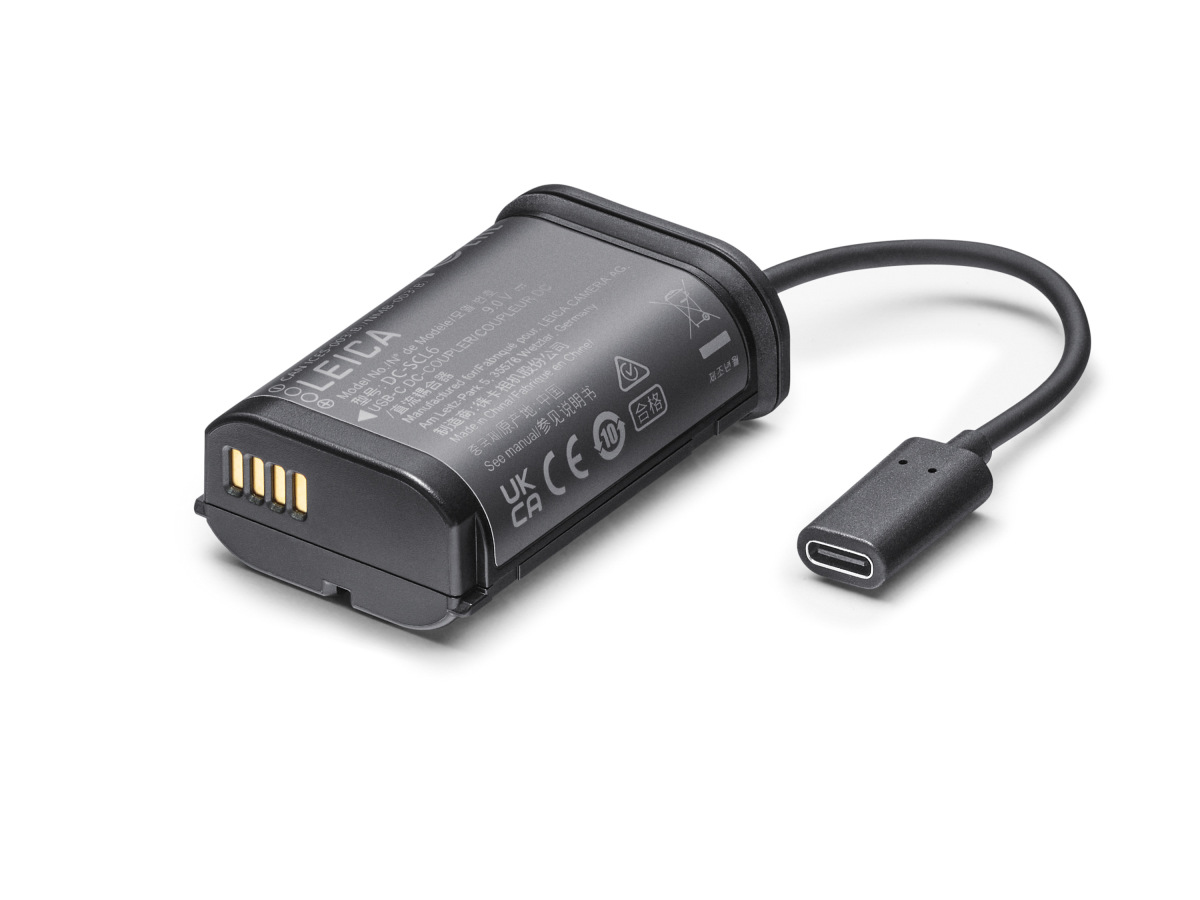
Rounding out the accessories is a new multifunction handgrip, the HG-SCL7. With a second shutter release button, joystick, thumb wheel and front dial, the handgrip offers the best vertical shooting experience. It also has space for a second battery, doubling the battery life of the camera. And the battery in the handgrip will charge from the camera’s USB-C port for those looking to use the setup in studio.
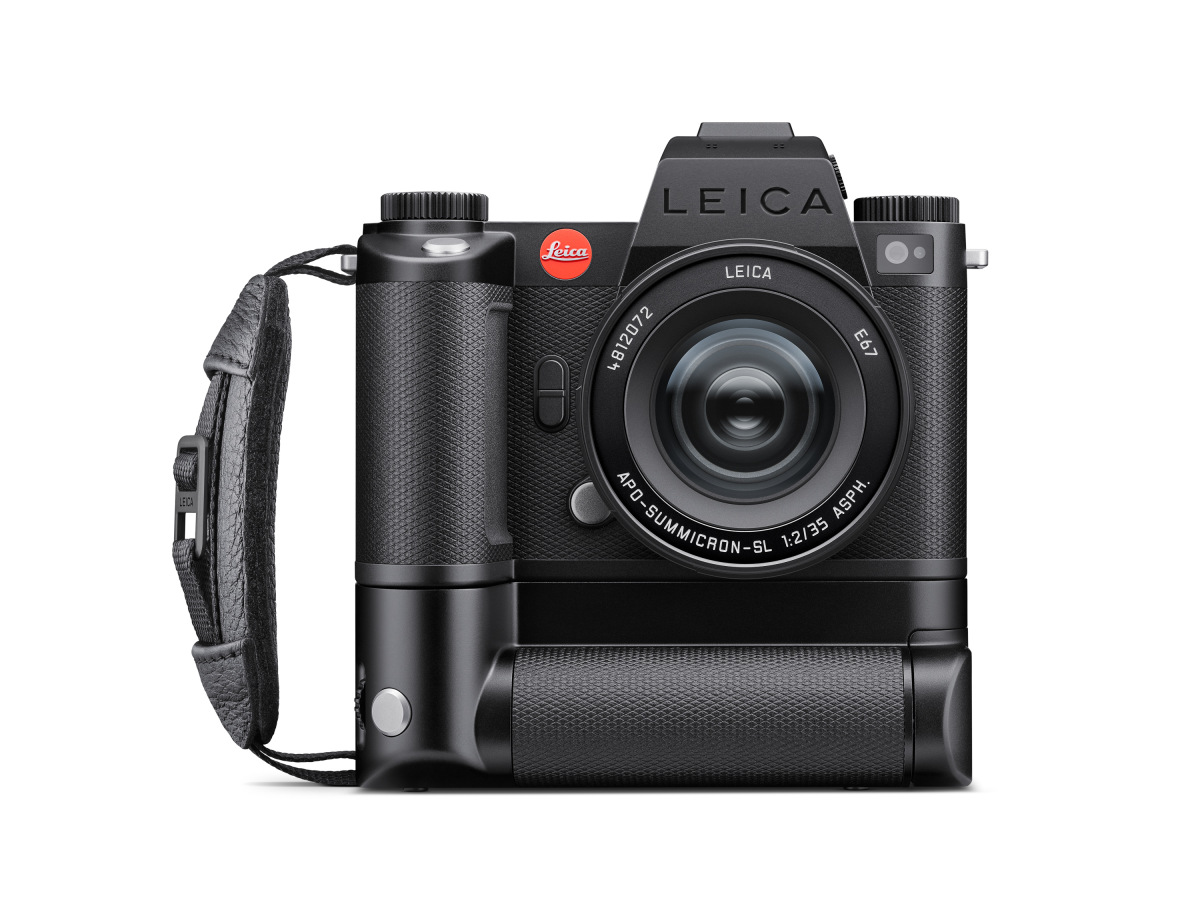
Thoughts on the SL3-S
All in all, we have a really nice evolution from the SL2-S and a nice complement to the SL3. The hybrid autofocus system is more advanced and responsive than ever with triple the AF detection points. ISO range has been expanded. Hand-held multishot offers high-resolution when required. 6K Open Gate looks to be a game changer for video shooters looking to take advantage of a wide range of full-frame Leica glass and leave the cropping to post. Direct to SSD recording, in-camera ProRes at all resolutions, and up to 6K RAW over HDMI provides myriad video production possibilities. The new body is smaller, lighter and more agile than before, without any compromise to durability or toughness. Improvements to both physical controls and touch functions combined with the tilting screen make a very ergonomic and intuitive system even more so. For those needing speed, low-light performance, superior autofocus and production-level video capabilities, with access to the best lenses available, the SL3-S just may be the camera for you.
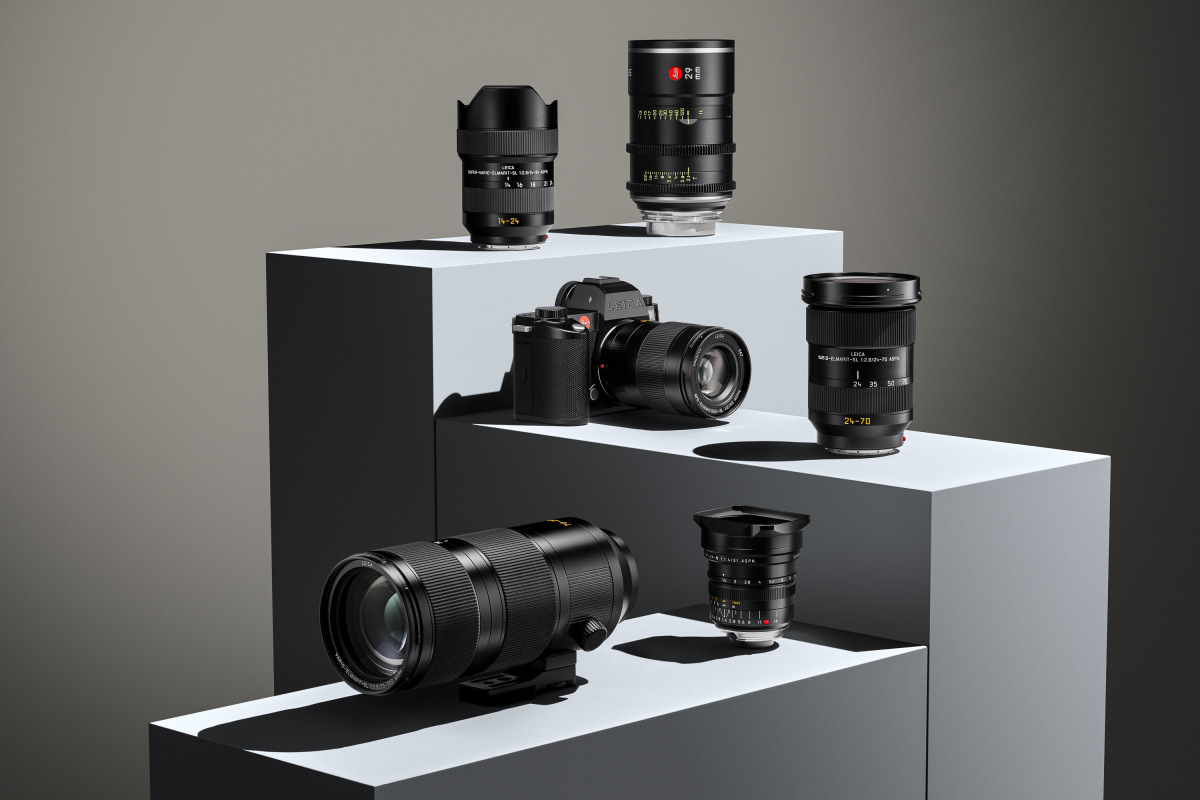
SL3 Video Content on Red Dot Forum YouTube
We've got a two hour Red Dot Forum Camera Talk livestream where we take a deep dive into the new camera and how it compares against the SL2 (We go live at 8pm EST 1/18/25). You can join us live, or use the same link to see the archived episode anytime in 4K. If you're not already subscribed, click here to get subscribed!
Pricing, Availability and Ordering
Initial deliveries of the Leica SL3-S will start within the next week for a price of $5,295. As with any major Leica camera launch, supply will be extremely limited for a number of months. If you are interested in ordering the SL3, you can do so at Leica Store Miami by clicking the button below, calling 305-921-4433 or sending an email to info@leicastoremiami.com. If you are interested in trading in any other Leica gear towards the purchase of the SL3-S, you can indicate so on the pre-order form.
SL3-S Compared to SL2-S
| Leica SL3-S | Leica SL2-S | |
| Sensor | 24 MP CMOS BSI | 24 MP CMOS |
| ISO Range | 50 – 200,000 | 50 – 100,000 |
| Dynamic Range | 15 stops | 14 stops |
| Processor | Maestro IV | Maestro III |
| Buffer | 8GB | 4GB |
| Display | 3.2 inch, 2.33 mill dots, tilting | 3.2 inch, 2.1 mill dots, fixed |
| EVF | Leica EyeRes®, Glass Optics, OLED 0.5″, 5.76 mill dots, 120 fps | Leica EyeRes®, Glass Optics, OLED 0.5″, 5.76 mill dots, 120 fps |
| AF System | Contrast & Phase Detection AF, DFD | Contrast Detection AF |
| AF Detection Points | 779 | 225 |
| Video Formats | 6K Open Gate, C6K, 6K, C4K, 4K, FHD | C4K, 4K, FHD, MP4 + MOV |
| ProRes 422 HQ Internal Recroding | Yes, up to C6K | No |
| ProRes RAW via HDMI to Atomos | Yes, up to 5.8K | Yes, up to C4K |
| Record to SSD Drive (USB-C) | Yes | No |
| External timecode sync | Yes | No |
| HDMI | HDMI 2.1 | HDMI 2.0 |
| Wireless | Wi-Fi 5(MIMO) / Bluetooth 5.1 | Wi-Fi 5 / Bluetooth 4.2 |
| Battery | 2200mAh (BP-SCL6) | 1860mAh (BP-SCL4) |
| Weight | 767 grams | 840 grams |
| Function Dials | 3 | 2 |
| Memory Cards | CF Express Type B; SD UHS II | SD UHS II |
| Custom Quick Menu | Yes | No |
| Touch Menu | Yes | No |
| UI Rotation | Yes | No |
| Live View Touch Icons | Yes | No |
| Apple MFI | Yes | No |
| Active Dust Removal | Yes | No |
| Multishot | 96MP – Handheld | 96MP – Tripod only |
Sample Images
Leica was nice enough to supply some sample images from the SL3-S. We'll be doing our own testing now that the camera is out, but after diving into these files, we're extremely impressed. Wonderful color and tonality. Exceptional detail and sharpness. Be sure to click on the images to see a larger view.
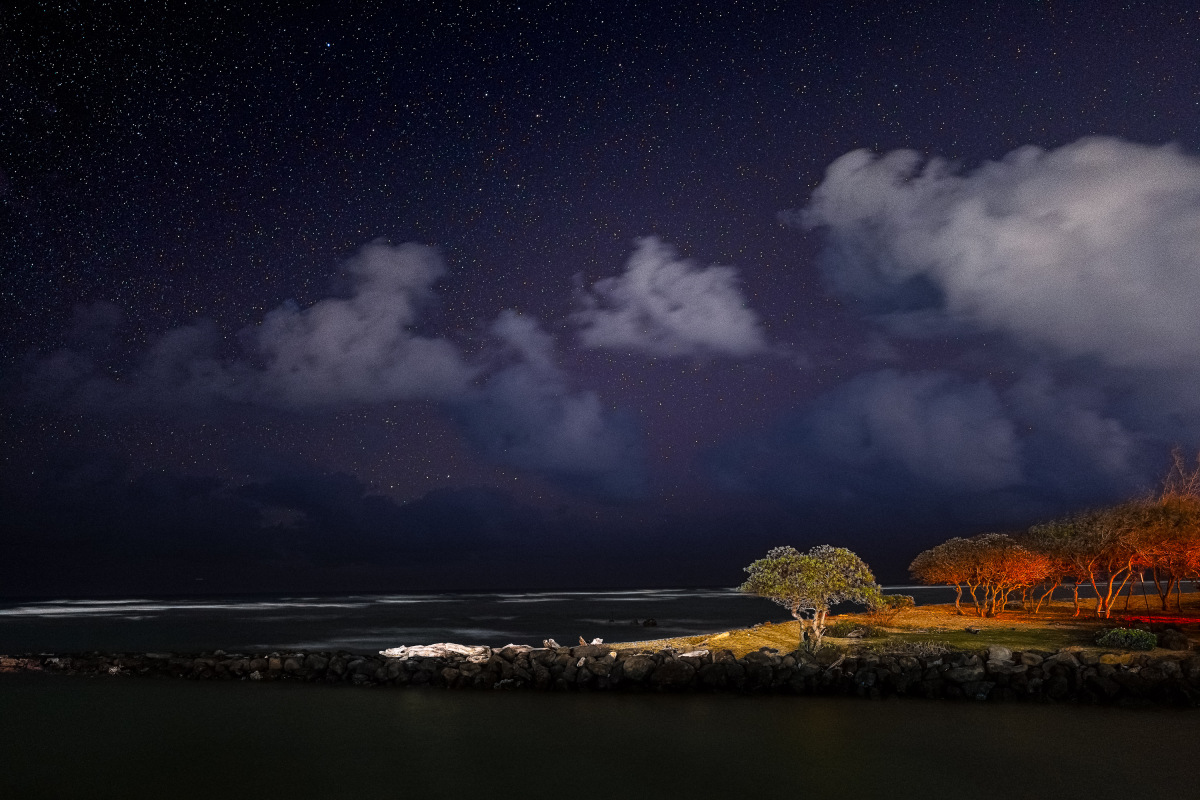

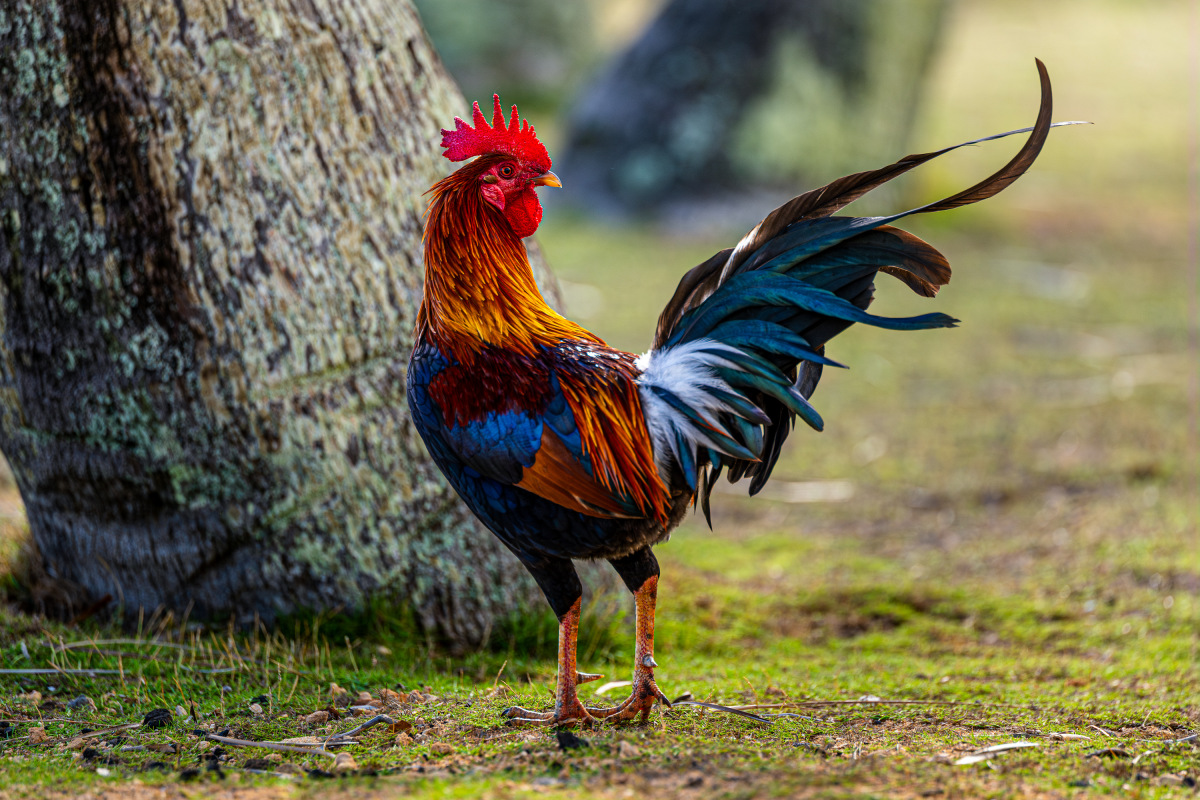
Tech Specs – Photo
| Designation | Leica SL3-S |
| Camera type | Mirrorless full-frame system camera |
| Type No. | 4506 |
| Order No. | 10 643 (EU/US/CN), 10 644 (JP), 10 645 (ROW) |
| Buffer memory | 8 GB |
| Frame Rate & Buffer Depth | 2 fps , 14 bit , AF: 1000 DNG, 1000 DNG + JPG, 1000 JPG 5 fps, 14 Bit: 1000 DNG, 345 DNG + JPG, 1000 JPG 7 fps, 12 Bit: 680 DNG, 255 DNG + JPG, 1000 JPG 15 fps, 12 Bit: 175 DNG, 175 DNG + JPG, 175 JPG 30 fps, 12 Bit: 175 DNG, 175 DNG + JPG, 175 JPG |
| Storage medium | UHS-II (recommended), UHS-I, SD/SDHC/SDXC card + CFexpress card type B (recommended) |
| Material | Full metal housing: magnesium and aluminum, leatherette covering, splash water protected in accordance with IEC Standard 60529 (protection type IP54) |
| Lens mount | Leica L bayonet with contact strip for communication between lens and camera |
| Operating conditions | −10 to +40°C |
| Interfaces | ISO accessory shoe with additional control contacts, synch jack/timecode interface, HDMI jack 2.1 Type A, USB-C USB3.1 Gen2, Audio-Out 3.5 mm/Audio-In 3.5 mm, communication interface in the bottom cover for multifunction handgrip |
| Tripod thread | A 1⁄4 DIN 4503 (1⁄4”) with stainless steel in the base |
| Dimensions | 152mm wide, 108mm high, 85mm deep |
| Weight | Approx. 768 g (without battery, SD card, body cap) |
| Sensor | CMOS sensor, 25.3 MP/24.6 MP (total/effective) |
| Image stabilization | 5-axis image stabilization up to 5-stops |
| Sensor Filter | RGB color filter, UV/IR filter, no low-pass filter |
| Processor | Leica Maestro series (Maestro IV) |
| File formats | Photo: DNG™ (raw data), DNG + JPG, JPG (DCF 2.0, Exif 3.0) |
| Image resolution | DNG / JPG (35mm): 6000 x 4000 pixels (24 MP) DNG / JPG (APS-C): 3936 x 2624 pixels (10.3 MP) |
| File size | DNG™: approx. 40 MB, depending on resolution and image content JPG: depending on resolution and image content |
| Color depth | DNG™: 14bit (12bit also possible depending on the continuous shooting mode), JPG: 8bit |
| Color space | sRGB |
| Viewfinder (EVF) | Resolution: 5,760,000dots, 60fps or 120fps, magnification: approx. 0.76x at aspect ratio: 3:2 / approx. 0.78x at aspect ratio: 4:3, frame coverage: 100%, exit pupil position: 21mm, setting range –4/+2dpt, with eye sensor for automatic switchover between viewfinder and LCD panel, time delay 0.005s |
| LCD panel | 3.2” (backlight LED) with anti-fingerprint and anti-scratch coating, 2,332,800 dots, format 3:2, touch panel |
| Shutter type | Electronically controlled focal plane shutter |
| Shutter speeds | Mech. shutter: 30 min to 1⁄8000 s, electr. shutter function: 60 s to 1⁄16000 s, flash synchronization: up to 1⁄200 s |
| Shutter button | Two-stage (1st stage: Activation of the camera electronics including autofocus and exposure metering, 2nd stage: Taking the picture) |
| Self-timer | Delay time: 2s, 6s, 12s or 30s |
| Drive Modes | Single, Continuous Shooting, Interval Shooting, Exposure Bracketing, Multi-shot |
| Continuous shooting | 2 fps, 14 bit, AF: Mech. or electr. shutter, AFc, even if AFs or Intelligent AF selected 5 fps, 14 bit, AF: Mech. or electr. shutter, AFc, even if AFs or Intelligent AF selected 7 fps, 12 bit: Mech. or electr. shutter, AFc, even if AFs or Intelligent AF selected 15 fps, 12 bit: Electr. shutter, AFc, even if AFs or Intelligent AF selected 30 fps, 12 bit: Electr. shutter, AFc, even if AFs or Intelligent AF selected |
| Focus Mode | Automatic or manual With manual setting: optional magnifying glass function (Magnification) and edge marking (Focus Peaking) available as focus assist |
| Autofocus system | Hybrid-AF due to combination of contrast metering, depth mapping, and phase comparison metering with AF metering points in the sensor |
| Autofocus modes | Intelligent AF (automatically refocuses as soon as something changes in the scene), AFs, AFc, AF setting can be saved, optional Touch AF |
| Autofocus metering methods | Multi-field, Spot (can be shifted), Field (can be shifted and scaled), Zone (can be shifted and scaled), Tracking, Eye/Face/Body Detection, Animals (Beta) |
| Autofocus metering fields | Contrast-AF: 315 / Phase detection-AF: 779 |
| Exposure metering | TTL (exposure metering through the lens) |
| Exposure metering methods | Spot, Center-Weighted, Highlight-Weighted, Multi-Field |
| Exposure modes | Program AE mode (P), aperture-priority mode (A): manual aperture setting, shutter-priority mode (S): manual shutter speed setting, Manual (M): manual setting for shutter speed and aperture |
| Exposure compensation | ±3EV in 1⁄3EV increments or 1⁄2EV increments |
| Automatic bracketing | 3 or 5 frames, graduations between shoots up to 3EV, in 1⁄3EV increments, additional optional exposure compensation: up to ±3EV |
| ISO sensitivity range | Photo (Auto ISO): 100-200,000 Photo (Manual ISO): 50-200,000 |
| Dual Basis ISO | Low Basis ISO (Photo): 50-560 High Basis ISO (Photo): 640-200,000 |
| White balance | Automatic (Auto), default (Daylight, Cloudy, Shadow, Tungsten, HMI, Fluorescent (warm), Fluorescent (cool), Flash), manual metering (Gray Card (pipette), Gray Card), manual color temperature settings (Color Temperature, 2000K to 11500K) |
| Flash unit connector | Via the accessory shoe |
| Flash synchro socket | For flash synchronization (photo mode only) |
| Flash sync time | 1⁄200s, slower shutter speeds available, automatic switchover to TTL linear flash mode with HSS-compatible Leica system flash units if sync time is undercut |
| Flash exposure metering | Using center-weighted TTL pre-flash metering with Leica flash units (SF26, SF40, SF58, SF60, SF64) or with system-compatible flash units, remote controlled flash SFC1 |
| Flash exposure compensation | SF40: ±2EV in 1⁄2EV increments SF60: ±2EV in 1⁄3EV increments |
| Microphone | Stereo internal + microphone input 3.5mm stereo jack |
| Speaker | Mono internal + headphones output 3.5mm stereo jack |
| WLAN | The Leica FOTOS app is required to use the WLAN function. The Leica app is available from the Apple App Store™ or the Google Play Store™. |
| 2.4 GHz (EU/US/CN) | IEEE802.11b/g/n: Channel 1–11 (2412–2462 MHz) |
| 5 GHz Client mode (indoor use only) | IEEE802.11a/n/ac: Channel 36–64 (5180–5320 MHz) |
| 5 GHz Access point + client mode | IEEE802.11a/n/ac: Channel 149–165 (5745–5825MHz) |
| Encryption method | WLAN-compatible WPA2™ |
| Bluetooth | Bluetooth 5.1 LE: Channel 0–39 (2402–2480MHz) |
| GPS | Not available everywhere due to country-specific legislation; can be added via the Leica FOTOS app. Data is written to Exif header of the picture files. |
| Menu languages | English, German, French, Italian, Spanish, Portuguese, Russian, Japanese, Simplified Chinese, Traditional Chinese, Korean |
| Rechargeable battery (Leica BP-SCL6) | Lithium-ion rechargeable battery, rated voltage: 7.2V (DC); capacity: 2200mAh (min.), 315 shots (based on CIPA standard), 1042 shots (based on CIPA standard with adapted shooting cycle*) with Displays/AF Auto Off = 5 s); manufacturer: Panasonic Energy (Wuxi) Co. Ltd., Made in China |
| USB-C power adapter (Leica ACA-SCL6) (optional) | Input: AC 100–240V, 50/60Hz, 0.25A, automatic switchover; Output: DC 5V/9V, 3A; Manufacturer: Salom Electric (Xiamen) Co., Ltd., Made in China |
| Dual Charger (Leica BC-SCL6) (optional) | Input: DC 5V/3A, 9 V/3A, automatic switchover; Output: DC 8.4V, 850 mA/1000mA; Manufacturer: Salom Electric (Xiamen) Co., Ltd., Made in China |
| Charging via USB | During operation: 9V/3A (min. 27W) With camera switched off: 5V/1500mA (2.5W or greater) |
| Scope of Delivery | Leica SL3-S, Battery (BP-SCL6), USB-C cable, Carrying strap, Quick Start Guide |
| Warranty (USA) | 2 years, extendable to 3 years |
Tech Specs – Video
| Video File Formats | MP4: h.265, AAC, 48 kHz/16 bit MP4: h.264, AAC, 48 kHz/16 bit MOV: h.265, LPCM, 48 kHz/24 bit MOV: h.264, LPCM, 48 kHz/24 bit MOV:ProRes 422HQ: LPCM, 48 kHz/24 bit RAW: LPCM, 48 kHz/24 bit |
| Video Length | Max length depending on ambient temperature and available memory space |
| Color Space | Rec. 709/Rec. 2020 (HLG/L-Log) |
| Video Resolution | 6K OG (3:2): 5952 x 3968 C6K (17:9): 5952 x 3136 6K (16:9): 5888 x 3312 (h.256) 6K (16:9): 5776 x 3056 (ProRes) C4K (17:9) 4096 x 2160 (MOV/MP4) C4K (17:9) 4128 x 2176 (RAW) 4K (16:9): 3840 x 2160 3.5K (4:3) 3536 x 2656 (RAW) FHD (16:9): 1920 x 1080 |
| Video frame rate/bit rate | |
| MOV 6K Open Gate (35mm) | 29.97 fps: 6K OG 4:2:0/10 bit (SD, CFe, HDMI, SSD), h.265, L-GOP, 200 Mbps 25.00 fps: 6K OG 4:2:0/10 bit (SD, CFe, HDMI, SSD), h.265, L-GOP, 200 Mbps 24.00 fps: 6K OG 4:2:0/10 bit (SD, CFe, HDMI, SSD), h.265, L-GOP, 200 Mbps 23.98 fps: 6K OG 4:2:0/10 bit (SD, CFe, HDMI, SSD), h.265, L-GOP, 200 Mbps |
| MOV C6K (35mm) | 29.97 fps: 6K OG 4:2:0/10 bit (SD, CFe, HDMI, SSD), h.265, L-GOP, 200 Mbps 25.00 fps: 6K OG 4:2:0/10 bit (SD, CFe, HDMI, SSD), h.265, L-GOP, 200 Mbps 24.00 fps: 6K OG 4:2:0/10 bit (SD, CFe, HDMI, SSD), h.265, L-GOP, 200 Mbps 23.98 fps: 6K OG 4:2:0/10 bit (SD, CFe, HDMI, SSD), h.265, L-GOP, 200 Mbps |
| MOV 6K (35mm) | 29.97 fps: 6K OG 4:2:0/10 bit (SD, CFe, HDMI, SSD), h.265, L-GOP, 200 Mbps 25.00 fps: 6K OG 4:2:0/10 bit (SD, CFe, HDMI, SSD), h.265, L-GOP, 200 Mbps 24.00 fps: 6K OG 4:2:0/10 bit (SD, CFe, HDMI, SSD), h.265, L-GOP, 200 Mbps 23.98 fps: 6K OG 4:2:0/10 bit (SD, CFe, HDMI, SSD), h.265, L-GOP, 200 Mbps |
| MOV C4K (APS-C) | 59.94 fps: 4:2:2/10 bit (CFe, HDMI, SSD), h.264, ALL-I, 800 Mbps 59.94 fps: 4:2:2/10 bit (SD, CFe, HDMI, SSD), h.264, ALL-I, 600 Mbps 50.00 fps: 4:2:2/10 bit (CFe, HDMI, SSD), h.264, ALL-I, 800 Mbps 50.00 fps: 4:2:2/10 bit (SD, CFe, HDMI, SSD), h.264, ALL-I, 600 Mbps 48.00 fps: 4:2:2/10 bit (CFe, HDMI, SSD), h.264, ALL-I, 800 Mbps 48.00 fps: 4:2:2/10 bit (SD, CFe, HDMI, SSD), h.264, ALL-I, 600 Mbps 47.95 fps: 4:2:2/10 bit (CFe, HDMI, SSD), h.264, ALL-I, 800 Mbps 47.95 fps: 4:2:2/10 bit (SD, CFe, HDMI, SSD), h.264, ALL-I, 600 Mbps |
| MOV 4K (35mm / APS-C) | 29.97 fps: 4:2:2/10 bit (SD, CFe, HDMI, SSD), h.264, ALL-I, 400 Mbps 25.00 fps: 4:2:2/10 bit (SD, CFe, HDMI, SSD), h.264, ALL-I, 400 Mbps 24.00 fps: 4:2:2/10 bit (SD, CFe, HDMI, SSD), h.264, ALL-I, 400 Mbps 23.98 fps: 4:2:2/10 bit (SD, CFe, HDMI, SSD), h.264, ALL-I, 400 Mbps |
| MOV 4K (APS-C) | 59.94 fps: 4:2:2/10 bit (CFe, HDMI, SSD), h.264, ALL-I, 800 Mbps 59.94 fps: 4:2:2/10 bit (SD, CFe, HDMI, SSD), h.264, ALL-I, 600 Mbps 50.00 fps: 4:2:2/10 bit (CFe, HDMI, SSD), h.264, ALL-I, 800 Mbps 50.00 fps: 4:2:2/10 bit (SD, CFe, HDMI, SSD), h.264, ALL-I, 600 Mbps 48.00 fps: 4:2:2/10 bit (CFe, HDMI, SSD), h.264, ALL-I, 800 Mbps 48.00 fps: 4:2:2/10 bit (SD, CFe, HDMI, SSD), h.264, ALL-I, 600 Mbps 47.95 fps: 4:2:2/10 bit (CFe, HDMI, SSD), h.264, ALL-I, 800 Mbps 47.95 fps: 4:2:2/10 bit (SD, CFe, HDMI, SSD), h.264, ALL-I, 600 Mbps |
| MOV 4K (35mm / APS-C) | 29.97 fps: 4:2:2/10 bit (SD, CFe, HDMI, SSD), h.264, ALL-I, 400 Mbps 25.00 fps: 4:2:2/10 bit (SD, CFe, HDMI, SSD), h.264, ALL-I, 400 Mbps 24.00 fps: 4:2:2/10 bit (SD, CFe, HDMI, SSD), h.264, ALL-I, 400 Mbps 23.98 fps: 4:2:2/10 bit (SD, CFe, HDMI, SSD), h.264, ALL-I, 400 Mbps |
| MOV FHD (35mm / APS-C) | 119.88 fps: 4:2:2/10 bit ((SD, CFe, HDMI, SSD), h.264, ALL-I, 400 Mbps 100.00 fps: 4:2:2/10 bit ((SD, CFe, HDMI, SSD), h.264, ALL-I, 400 Mbps 59.94 fps: 4:2:2/10 bit (SD, CFe, HDMI, SSD), h.264, ALL-I, 200 Mbps 50.00 fps: 4:2:2/10 bit (SD, CFe, HDMI, SSD), h.264, ALL-I, 200 Mbps 48.00 fps: 4:2:2/10 bit (SD, CFe, HDMI, SSD), h.264, ALL-I, 200 Mbps 24.00 fps: 4:2:2/10 bit( SD, CFe, HDMI, SSD), h.264, ALL-I, 200 Mbps 47.95 fps: 4:2:2/10 bit (SD, CFe, HDMI, SSD), h.264, ALL-I, 200 Mbps 29.97 fps: 4:2:2/10 bit ((SD, CFe, HDMI, SSD), h.264, ALL-I, 200 Mbps 25.00 fps: 4:2:2/10 bit (SD, CFe, HDMI, SSD), h.264, ALL-I, 200 Mbps 24.00 fps: 4:2:2/10 bit (SD, CFe, HDMI, SSD), h.264, ALL-I, 200 Mbps 23.98 fps: 4:2:2/10 bit (SD, CFe, HDMI, SSD), h.264, ALL-I, 200 Mbps |
| MOV FHD Slow Motion (35mm / APS-C) | Sensor: 179.82 fps Recording/Playback: 29.97 fps: 4:2:0/10 bit (SD, CFe, HDMI, SSD), h.265, L-GOP, 100 Mbps Sensor: 150.00 fps Recording/Playback: 25.00 fps: 4:2:0/10 bit (SD, CFe, HDMI, SSD), h.265, L-GOP, 100 Mbps Sensor: 119.88 fps Recording/Playback: 29.97 fps: 4:2:0/10 bit (SD, CFe, HDMI, SSD), h.265, L-GOP, 100 Mbps Sensor: 100.00 fps: Recording/Playback: 25.00 fps: 4:2:0/10 bit (SD, CFe, HDMI, SSD), h.265, L-GOP, 100 Mbps |
| C6K – ProRes (35mm) | 29.97 fps: C6K 4:2:2/10 bit (CFe, HDMI, SSD), ProRes 422HQ, 1939 Mbps 25.00 fps: C6K 4:2:2/10 bit (CFe, HDMI, SSD), ProRes 422HQ, 1618 Mbps 24.00 fps: C6K 4:2:2/10 bit (CFe, HDMI, SSD), ProRes 422HQ, 1533 Mbps 23.98 fps: C6K 4:2:2/10 bit (CFe, HDMI, SSD), ProRes 422HQ, 1551 Mbps |
| C4K – ProRes (APS-C) | 59.94 fps: C4K 4:2:2/10 bit (CFe, HDMI, SSD), ProRes 422HQ, 1944 Mbps 50.00 fps: C4K 4:2:2/10 bit (CFe, HDMI, SSD), ProRes 422HQ, 1622 Mbps |
| C4K – ProRes (35mm / APS-C) | 29.97 fps: C4K 4:2:2/10 bit (CFe, HDMI, SSD), ProRes 422HQ, 927 Mbps 25.00 fps: C4K 4:2:2/10 bit (CFe, HDMI, SSD), ProRes 422HQ, 811 Mbps 24.00 fps: C4K 4:2:2/10 bit (CFe, HDMI, SSD), ProRes 422HQ, 779 Mbps 23.98 fps: C4K 4:2:2/10 bit (CFe, HDMI, SSD), ProRes 422HQ, 778 Mbps |
| FHD – ProRes (35mm / FHD) | 59.94 fps: FHD 4:2:2/10 bit (SD, CFe, HDMI, SSD), ProRes 422HQ, 454 Mbps 50.00 fps: FHD 4:2:2/10 bit (SD, CFe, HDMI, SSD), ProRes 422HQ, 378 Mbps 29.97 fps: FHD 4:2:2/10 bit (SD, CFe, HDMI, SSD), ProRes 422HQ, 227 Mbps 25.00 fps: FHD 4:2:2/10 bit (SD, CFe, HDMI, SSD), ProRes 422HQ, 189 Mbps 24.00 fps: FHD 4:2:2/10 bit (SD, CFe, HDMI, SSD), ProRes 422HQ, 182 Mbps 23.98 fps: FHD 4:2:2/10 bit (SD, CFe, HDMI, SSD), ProRes 422HQ, 181 Mbps |
| 6K – HDMI-RAW (35mm) | 29.97 fps 25.00 fps 23.98 fps |
| C4K – HDMI-RAW (APS-C) | 59.94 fps 50.00 fps 29.97 fps 25.00 fps 23.98 fps |
| 3.5K – HDMI-RAW (APS-C) | 50.00 fps 29.97 fps 25.00 fps 23.98 fps |
| Bit Rate | 8bit/10bit for recordings on SD and CFe card, 10bit/12bit for HDMI output |
| Video Gamma | Rec. 709, L-Log Rec. 2020, HLG Rec. 2020 Further information can be found in the “L-Log Reference Manual” for download on the Leica homepage. |
| ISO sensitivity range (Video) | Video (Auto ISO): 100-200,000 Video (Manual): 50-200,000 L-Log (Auto ISO): 400-100,000 L-Log (Manual): 400-100,000 HLG (Auto ISO): 400-200,000 HLG (Manual): 400-200,000 |
| Dual Basis ISO | Low Basis ISO Video: 50-560 High Basis ISO Video: 640-200,000 Low Basis ISO L-Log: 400-2200 High Basis ISO L-Log: 2500-100,000 Low Basis ISO HLG: 400-2200 High Basis ISO HLG: 2500-200,000 |
Press Release
Leica SL3-S: The new full-frame system camera with a 24 megapixel sensor, fast autofocus and enhanced video functions is now available.
Teaneck, January 16th, 2025. Leica Camera AG launched the SL-System in 2015, seamlessly blending photography and videography in a unique way right from the very start. With this full-frame system based on the L-Mount standard, Leica firmly established itself in the world of professional audiovisual production. The latest version of SL-System cameras is the Leica SL3, which was launched in March 2024. As with all Leica products, it fulfills the highest standards of image and production quality, setting new benchmarks for ease of use with its unique user interface. These values are now embodied in a new SL-System camera: the Leica SL3-S.
When developing the Leica SL3-S, Leica focused on the high demands of professional photography and videography. In doing so, the brand prioritized speed, flexibility and versatility. The result is a camera that combines the highest image quality for both photography and videography with optimum working speed and reliability. The Leica SL3-S integrates state-of-the-art technology into an outstanding design. It also offers numerous new functions that ensure a professional workflow for producing audiovisual content.
A new BSI CMOS full-frame sensor with 24-megapixel native resolution, 48- and 96-megapixel multi- shot modes, and a new autofocus system form the core of the Leica SL3-S. Securely protected by an IP54-certified solid all-metal body, Leica combines the strengths of three focus technologies here: the latest generation in phase detection AF (PDAF), depth map (object detection AF) and contrast detection AF enable continuous shooting with the Leica SL3-S at up to 30 frames per second with full autofocus support. This makes the SL3-S the fastest Leica system camera ever built. Together with a high dynamic range and the impressive ISO range of 50 to 200,000, the SL3-S delivers excellent- quality photos and videos in all shooting situations.
The SL3-S is the first camera in the SL-System to be equipped with Content Credentials technology in accordance with the Content Authenticity Initiative (CAI) and its underlying technical standard, the Coalition for Content Provenance and Authenticity’s (C2PA) Content Credentials for photos. If desired, each image can be signed with tamper-proof metadata, such as the camera model and author information, as well as creation and editing data. In order to prove authenticity with verifiable image content and to make edits transparent, the Content Credentials can be viewed using freely available verification tools (contentauthenticity.adobe.com/inspect).
The Leica SL3-S records videos in a resolution of up to 6K and offers 3:2 open-gate recording, a feature that provides flexibility when creating video content for a wide variety of channels. For example, portrait format videos can be recorded in 4K, 9:16 without any loss of quality and the field of view in recorded material can also be determined retrospectively. The Leica SL3-S records HDMI- RAW in 5.9K at 30 fps to external display recorders. What’s more, thanks to the fast CFexpress type B interface, ProRes 4:2:2 HQ in 5.8K at 30 fps or C4K at 60 fps can also be internally recorded without any recording time limits. It is also possible to record directly to an external SSD hard drive via the USB-C interface, which further increases the flexibility of the Leica SL3-S. A dedicated timecode interface enables professional synchronization of image and sound on set. The Maestro IV processor with L2 technology effortlessly handles enormous amounts of data, resulting in images with superb color rendering, high dynamic range and excellent noise behavior in the L-Log color space. This processor has been lauded internationally for its optimal quality.
The versatile interfaces and powerful connectivity of the SL3-S ensure a seamless professional workflow. It has slots for CFexpress type B and UHS-II SD memory cards, a USB-C port for fast data transfer, tethering, SSD connection or power supply, and a full-size HDMI 2.1 output for external LCD panels or recording devices. In addition, Bluetooth and Wi-Fi with MIMO technology enable fast, stable connection to the Leica FOTOS App, with which DNG images can be transferred in full resolution in a matter of seconds. As a certified Apple “Made for iPhone® and iPad®” accessory, the Leica SL3-S can be connected directly to Apple products using the supplied USB-C cable. Over the course of 2025, the Camera-to-Cloud function will also become available via Adobe frame.io, using which videos and photos can be uploaded directly from the camera to the Adobe frame.io cloud for further processing.
Thanks to the L-Mount, the Leica SL3-S can be combined with the outstanding lenses for all Leica camera systems, as well as the broad range from super wide-angle lenses to super telephoto zoom lenses from the L-Mount alliance partners. Various Cine lenses can also be used via adapters, the special scales for which can be found in the video menu of the Leica SL3-S. The lens bayonet mount ensures that the Leica SL3-S offers comprehensive system compatibility. In addition, the legendary Leica M-Lenses’ full potential can be harnessed thanks to the special design of the image sensor and an external light sensor. Photographers and videographers benefit from the unrivalled imaging performance and compact design of the Leica M-Lenses together with the incredible features of the SL3-S. Image stabilization of up to 5 stops integrated into the camera body further extends the range of applications for M-Lenses.
The EyeRes® viewfinder of the Leica SL3-S is equipped with a painstakingly produced optical system of glass lenses. It displays the subject crystal clear at all times with up to 120 images per second and a resolution of 5.76 million pixels. Thanks to the live preview, it offers full control over the exposure and composition of shots even before the shutter is released. Another new feature of the SL3-S is the tilting 3.2-inch high-res touchscreen with a high-quality tilting mechanism, which makes it even easier to take photos and videos from different angles.
A further highlight is the interface, already familiar to users of the SL3. As with the SL3, the optimizations to the SL3-S include ergonomic and haptic features, as well as the user interface and menu navigation. The clearly structured icon and menu design makes navigation even easier, with distinct sections for photo and video functions. The Cine mode has been tailored specifically to the needs of professional video production.
Freely assignable FN buttons and optimized touch interaction throughout the camera menu allow for intuitive and convenient operation. When taking photos and filming, the entire user interface of the SL3-S aligns itself in landscape or portrait format according to the camera position. The SL3-S is noticeably lighter and more compact than its predecessors and feels even better in the hand thanks to its optimized design. In addition, the complete range of accessories already available for the Leica SL3 are also compatible with the SL3-S.

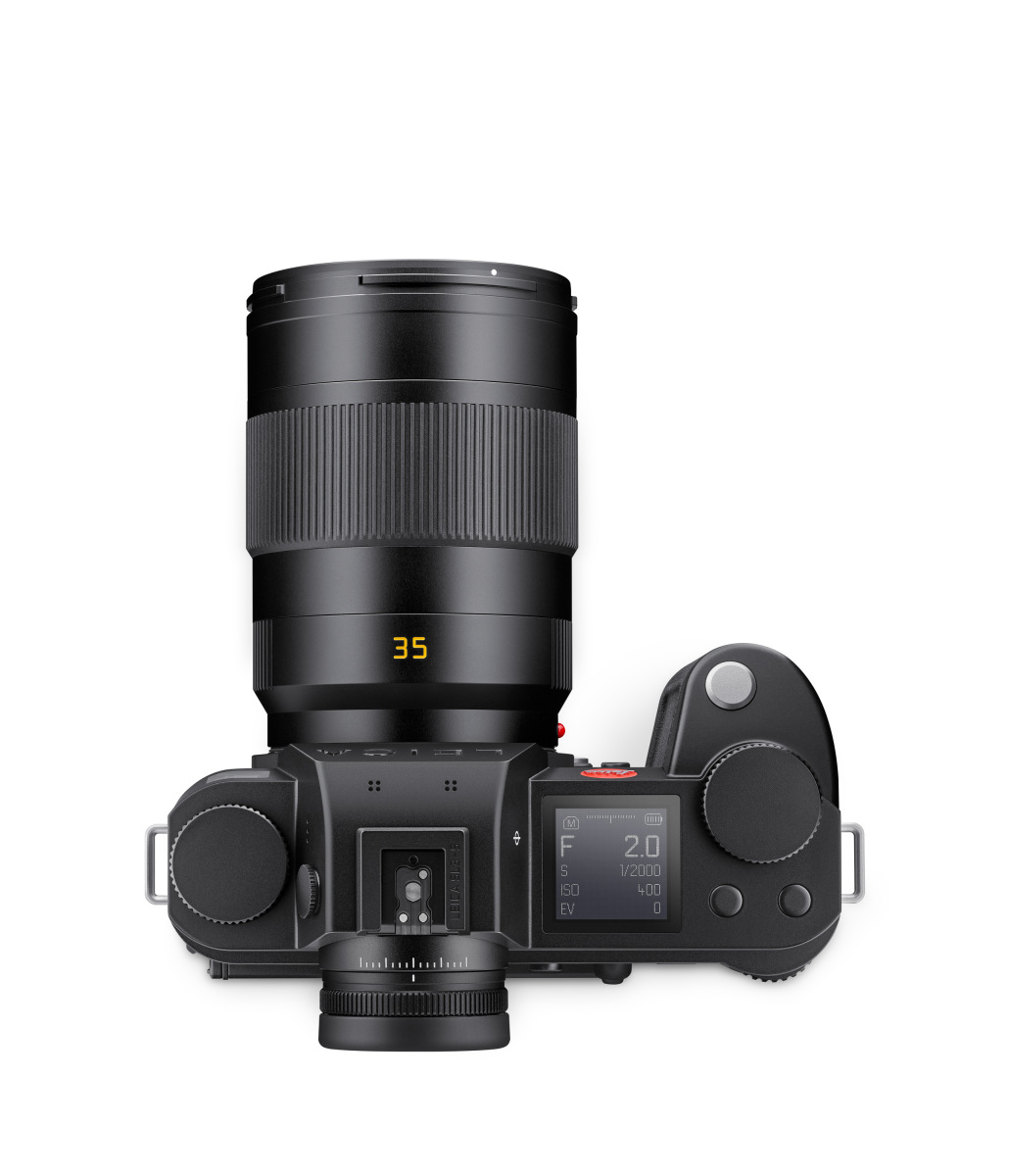
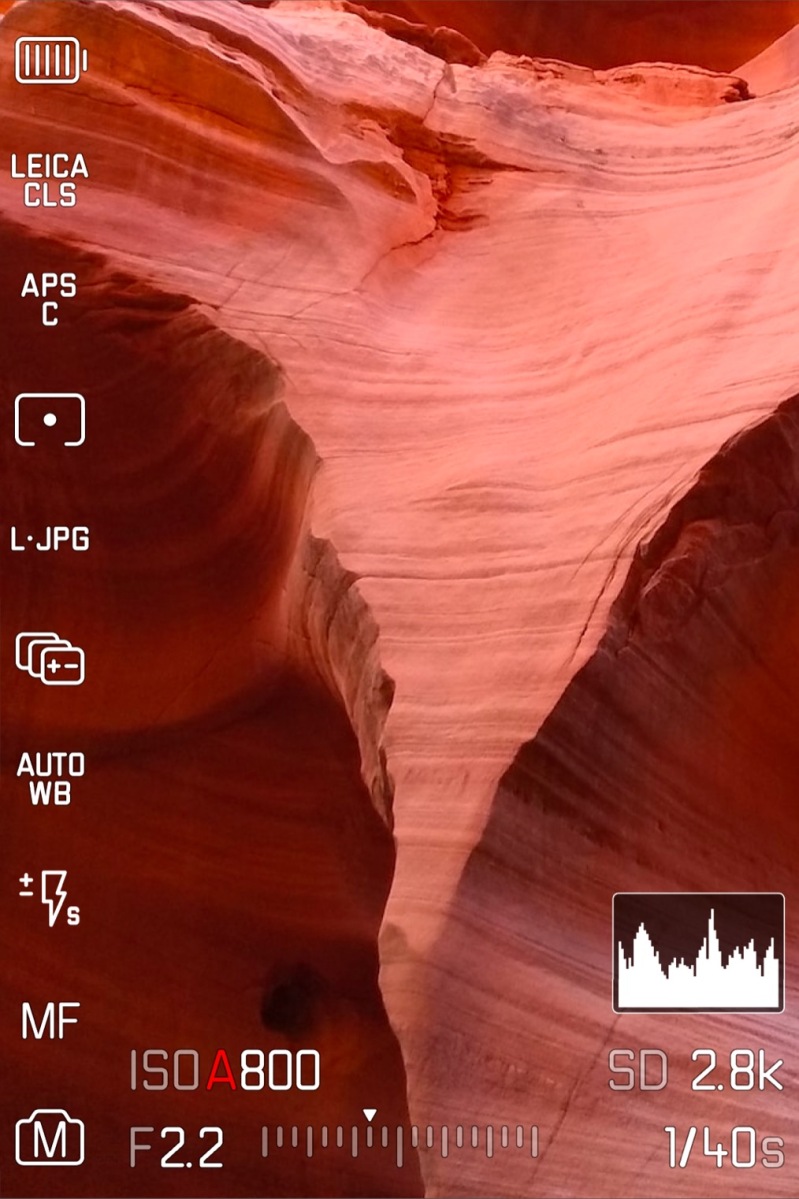




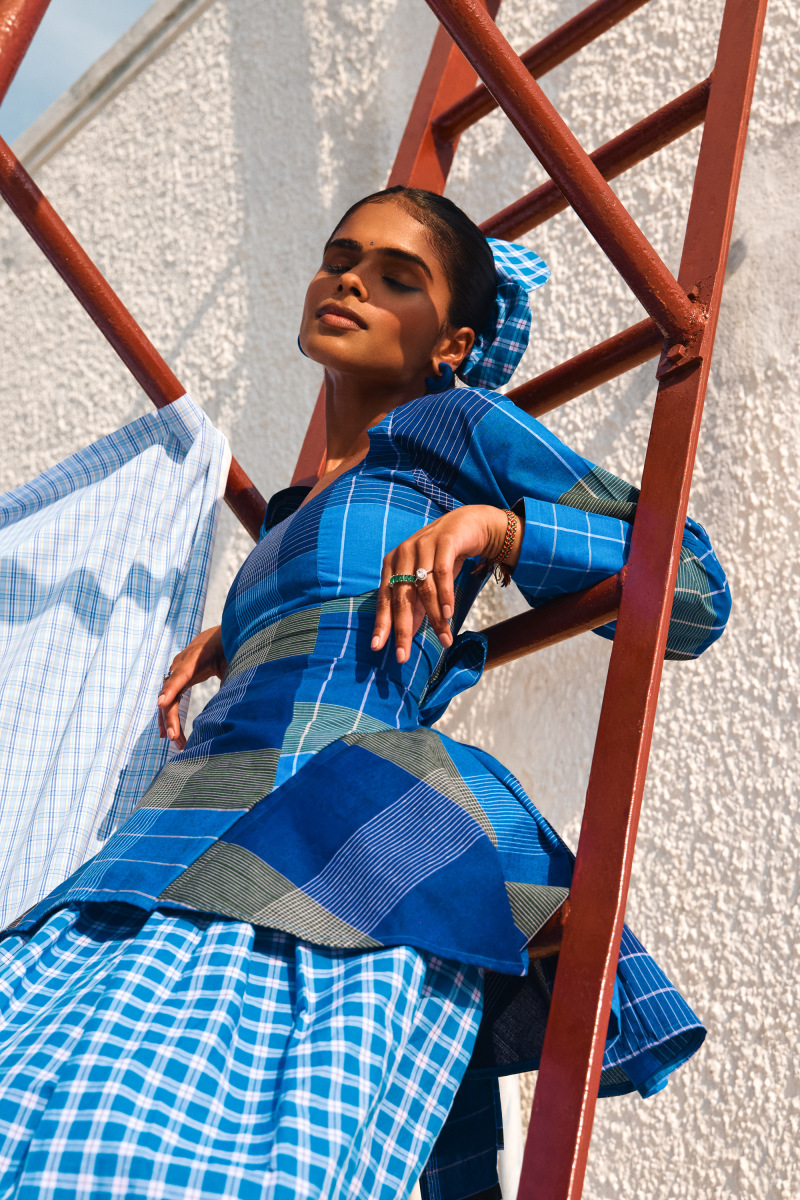
Does the viewfinder image lessen in quality when autofocusing?
It does on my Q3 (not sure if framerate and/or resolution), but the SL3-3 does have more computing power per pixel, while being the same processor.